SIEMENS
Making cooking as much fun as eating
Please read this instruction manual. This will ensure that you make full use of all the technical benefits the steam oven has to offer.
It will provide you with important safety information. You will be familiarised with the individual components of your new appliance. And we will show you how to make settings step by step. It is quite simple.
The tables list the adjustment values and shelf levels for numerous well-known dishes. All these dishes are tested in our cooking studio.
In the unlikely event of a malfunction, look here for information on how to rectify minor faults yourself.
A detailed table of contents will help you to find your way around quickly.
Enjoy your meal!
Instruction manual
HB24D.52. HB24D582.
en
9000 350 169
Table of contents
| Safety information | 4 |
|---|---|
| Causes of damage | 5 |
| Your new appliance | 7 |
| Control panel | 7 |
| Operating modes | 8 |
| Cooking compartment and accessories | 8 |
| Water tank | 10 |
| Automatic calibration | 11 |
| Before using for the first time | 12 |
| Set clock | 12 |
| Setting the water hardness range | 12 |
| Cleaning | 13 |
| Operating the appliance | 14 |
| Switching on the appliance | 14 |
| Switching off the appliance | 14 |
| After every operation | 15 |
| Setting the time-setting options | 16 |
| Setting the timer | 16 |
| Setting the duration | 17 |
| Setting a later end time | 18 |
| Setting the clock | 20 |
| Automatic programmes | 21 |
| Setting the programme | 21 |
| Notes about the programmes | 22 |
| Programme table | 24 |
| Childproof lock | 26 |
Table of contents
| Basic settings | 26 |
|---|---|
| Care and cleaning | 28 |
| Cleaning agents | 29 |
| Descaling | 30 |
| Removing and fitting the appliance door | 32 |
| Cleaning the rails | 33 |
| Cleaning the door panels | 34 |
| Troubleshooting | 35 |
| Replacing the cooking compartment bulb | 38 |
| Changing the door seal | 39 |
| After-sales service | 40 |
| E number and production number | 40 |
| Energy and environment tips | 41 |
| Saving energy | 41 |
| Environmentally-friendly disposal | 41 |
| Tables and tips | 42 |
| Vegetables | 43 |
| Side dishes and pulses | 44 |
| Meat, poultry, fish | 45 |
| Soup ingredients | 47 |
| Desserts, compote | 47 |
| Defrosting | 48 |
| Proving dough | 50 |
| Juicing | 50 |
| Preserving | 51 |
| Deep-frozen foods | 52 |
▲ Safety information
| Please read this instruction manual carefully. | |
|---|---|
|
This appliance is intended only for domestic use.
This appliance must only be used for food preparation. |
|
| Neither adults nor children should operate the appliance without supervision: | |
|
|
|
|
| Never let children play with the appliance. | |
| Hot cooking compartment |
Risk of burning.
Never touch the hot surfaces of heating and cooking appliances or the hot surfaces in the cooking compartment. Open the cooking compartment door carefully. Hot steam will escape. Small children must be kept at a safe distance from the appliance at all times. |
|
Risk of fire.
Never store combustible items in the cooking compartment. |
|
|
Risk of short-circuiting.
Never trap connecting cables of electrical appliances in the hot appliance door. The cable insulation could melt. |
|
|
Risk of burning.
Never prepare food containing large quantities of drinks with a high alcohol content. Alcoholic vapours can catch fire in the cooking compartment. Only use small quantities of drinks with a high alcohol content and open the appliance door carefully. |
|
| Hot accessories |
Risk of burning.
Always use an oven cloth or oven gloves to remove hot accessories from the appliance. |
| Hot water |
Risk of scalding.
Do not clean the appliance immediately after switching it off. The water in the evaporator dish is still hot. Wait until the appliance has cooled down. |
|---|---|
| Incorrect repairs |
Danger of electric shock.
Incorrect repairs are dangerous. Repairs may only be carried out by one of our trained after-sales engineers. |
|
If the appliance is faulty, switch off the circuit breaker
in the fuse box or disconnect the appliance at the mains. Contact the after-sales service. |
Causes of damage
|
Do not place anything on the cooking compartment
floor. Do not cover it with aluminium foil. A build-up of heat could damage the appliance. The cooking compartment floor and the evaporator dish must always be kept clear. Always place ovenware on the wire rack or in the perforated cooking container. |
|---|
|
Aluminium foil in the cooking compartment must not
come into contact with the door panel. This could cause permanent discolouration of the door panel. |
| Ovenware must be heat and steam resistant. |
|
Do not use ovenware that shows signs of rust. Even
the smallest spots of rust can lead to corrosion in the cooking compartment. |
|
When steaming in the perforated cooking container,
always insert the solid cooking container underneath. Dripping liquid is caught. |
|
Do not store moist food in the closed cooking
compartment for long periods. It can lead to corrosion in the cooking compartment. |
Very dirty door seal If the door seal is very dirty, the appliance door will no longer close properly during operation. The fronts of adjacent units could be damaged. Always keep the door seal clean and replace when necessary.
Weight on the appliance door
Transporting the appliance
Care and cleaning
Do not place anything on the open appliance door. The appliance could be damaged.
Do not carry or hold the appliance by the door handle. The door handle could break.
The cooking compartment in your appliance is made of high grade stainless steel. Improper care can lead to corrosion in the cooking compartment. Refer to the care and cleaning instructions in the instruction manual. Remove dirt from the cooking compartment as soon as the appliance has cooled.
Your new appliance
In this section, you will find information on
- the control panel
- the operating modes
- the cooking compartment and accessories

| Control element | Use | |
|---|---|---|
| Operating mode selector | Selects the operating mode | |
| Function buttons |
Selects the time-setting options
(see Section: Time-setting options) |
|
| -+ | Changes the values for clock, duration, weight etc. | |
| kg | Sets the weight of the food (see Section: Automatic programmes) | |
| 0 | Switches the childproof lock on and off (see Section: Childproof lock) | |
| Start/Stop button |
start
stop |
Press briefly: Starts and stops (pauses) an operation |
| Long press: Ends the operation | ||
| Temperature selector | C | Sets the temperature (see section: Switching on the appliance) |
Pop-out control knobs
The operating mode selector and temperature selector are pop-out switches. To pop the knob in and out, push the appropriate operating knob.
Operating modes
You can set the following operating modes using the operating mode selector.
| Operating modes | Application | |
|---|---|---|
| Steam 35 - | - 100 °C |
For vegetables, fish, side dishes, for juicing fruit and for
blanching. For proving dough (at 35 °C). The food is completely surrounded by steam. |
| The second secon | 60 °C |
For vegetables, meat, fish and fruit.
The moisture gently transfers the heat to the food. The food does not dry out or lose shape. |
| E Descale | For descaling the water system and the evaporator dish (see section: Descaling) | |
|
P Automatic
programmes |
Preset programmes
(see section: Automatic programmes) |
Cooking compartment and accessories
The cooking compartment has four shelf positions. The shelf positions are counted from the bottom up.
Caution
- The evaporator dish must not be covered. Do not place any dishes on the cooking compartment floor.
- Do not slide any accessories between the shelf positions, or they may tip.

Accessories
Use only the accessories supplied with the product or available from the after-sales service. They are specially designed for your appliance.
Your appliance is equipped with the following accessories:

Cooking container, solid, GN 2/3, 40 mm deep for catching dripping liquid when steaming and for cooking rice, pulses and
cereals

Cooking container, perforated, GN 2/3, 40 mm deep for the steaming of whole fish or large quantities of vegetables, for juicing berries, etc.
You can obtain further accessories from specialist retailers:
| Accessories | Order no. |
|---|---|
| Cooking container, solid, GN 2 / 3 , 40 mm deep | HZ36D533 |
| Cooking container, perforated, GN 2 / 3 , 40 mm deep | HZ36D533G |
| Cooking container, solid, GN 2 / 3 , 28 mm deep(baking tray) | HZ36D532 |
| Cooking container, solid, GN 1/3 , 40 mm deep | HZ36D513 |
| Cooking container, perforated, GN 1/3 , 40 mm deep | HZ36D513G |
| Wire rack | HZ36DR |
| Cleaning sponge | 643 254 |
| Descaler | 311 138 |
| Honeycomb microfibre cloth | 460 770 |
Water tank
When you open the appliance door, you will see the water tank on the right-hand side.
Only fill the water tank with fresh tap water or with still bottled water. If your water is very hard, we recommend that you use softened water.
For tap water with a high chloride content (> 40 mg/l), use a low-chloride, uncarbonated mineral water. You can obtain information on your tap water from your water supplier.
Before using for the first time, moisten the seal in the tank cover with a little water.
Caution.
Do not fill the water tank with distilled water or any other liquids. You may damage the appliance.

Fill the water tank.
- 1. Fill the water tank with cold water up to the "max." mark.
- 2. Close the tank cover until you feel it engage.
- 3. Slide in the water tank until it engages.
Empty the water tank after each use.
- 1. Pull the water tank out of the appliance slowly, keeping it horizontal, so that no remaining water can drip out of the valve.
- 2. Empty out the water.
- 3. Thoroughly dry the water tank in the appliance and the seal in the tank cover.
Before each use
After every operation
Display 🖰
If the water tank is empty, a signal sounds and the
- 1. Open the appliance door carefully. Steam will escape.
- 2. Remove the water tank, fill it with water and reinsert it.
- 3. Press the start button.
The boiling temperature of water depends on the air pressure. During calibration, the appliance is set to the pressure ratios at the place of installation. This occurs automatically when steaming for the first time at 100 °C. This causes more steam to develop than usual.
After moving house
Automatic
calibration
So that the appliance automatically adjusts itself to the new location, you must reset the appliance to the factory settings (see Section: Basic settings).
Before using for the first time
In this section you will find out,
- how to set the clock after connecting up your appliance
- how to change the water hardness rangeif required
- how to clean your appliance before using it for the first time
Set clock
After the oven has been connected, symbol () and three zeros light up on the display. Set the time.
- Press the button The time 12:00 is shown in the display.
- 2. Use button + or to set the clock.
After a few seconds, the time set is adopted.
Setting the water hardness range
Descale your appliance regularly. This is the only way to prevent damage.
Your appliance automatically displays when it needs descaling. It is preset to water hardness range II. Change the value if your water is softer or harder.
Checking the water hardness
Softened water
Changing the water hardness range
You can check the water hardness with the test strips supplied or ask your water supplier.
You can only dispense with descaling completely if you exclusively use softened water. If this is the case, change the water hardness range to "softened".
You can change the water hardness range in the basic settings when the appliance is switched off.
- 1. Switch off the appliance.
- Press and hold the button until 22 appears in the display.
- 3. Press the (b) button until c 52 appears.
- Press button or + to change the water hardness range.
Possible values:
| c 50 | softened | |
|---|---|---|
| c5 / | 1-soft | Ι |
| c 52 | 2-medium | Ш |
| c53 | 3-hard | |
| c54 | 4-very hard | IV |
5. Press and hold down the (b) button to leave Basic settings.
The change is saved.
| 1 1 | 00 | n | nn |
| J | Ed | I IU | |
| • |
Heating up the appliance
Heat up the appliance when empty before first use and clean the accessories.
- 1. Fill and insert the water tank.
- 2. Set the operating mode selector to 🖄 Steam.
- 3. Set the temperature selector to 100 °C.
- 4. Press the stop button.
The appliance heats up to 100 °C and switches off automatically after 20 minutes. A signal sounds.
5. Turn the operating mode and temperature selectors back to the o position to end the operation.
Leave the appliance door ajar until the appliance has cooled down.
Cleaning the accessories before use
Clean the accessories thoroughly before first use using a cloth and soapy water.
13
Operating the appliance
In this section you will find out,
- how to switch the appliance on and off
- what to note after each use
Switching on the appliance
- 1. Turn the operating mode selector to the required operating mode.
- 2. Turn the temperature selector to set the temperature.
| Operating mode | Temperature range |
|---|---|
| 🗟 Steam | 35 - 100 ℃ |
| Defrost | 35 - 60 °C |
| E Descale |
for operation see Section:
Descaling |
|
P Automatic
programmes |
for operation see Section:
Automatic programmes |
A default Duration appears in the display.
- 3. Use the + or button to set the Duration.
- 4. Press the stop button.
The appliance heats up. In the Steam operating mode, the Duration does not start counting down until the heating-up time has finished.
Changing the temperature
The temperature can be changed at any time. To do this, turn the temperature selector.
Switching off the appliance

Risk of scalding
Hot steam can escape when the appliance door is opened. Open the appliance door very carefully after cooking.
| The duration has elapsed |
When the duration is finished, your appliance
switches off automatically. A signal sounds. Press the |
|---|---|
| Turn the operating mode and temperature selectors back to the o position. Open the appliance door carefully. | |
| Pause | Press the stop button. The cooling fan may continue to run. Press the stop button to start. |
|
If you open the appliance door during an operation,
the operation is interrupted. Close the appliance door and press the stop button to restart. |
|
| If you have switched on the basic setting "Continue after closing door", restarting is not required (see section: Basic settings). | |
| Switching off | Press the stop button. Turn the operating mode and temperature selectors back to the o position. Open the appliance door carefully. |
| The cooling fan may continue running when you open the appliance door. | |
After every operation
| - | |
|---|---|
| Emptying the water tank | Empty the water tank. Thoroughly dry the seal in the tank cover and the tank shaft in the appliance. |
| Do not dry the water tank in the hot cooking compartment. This will damage the water tank. | |
|
Drying the cooking
compartment |
Leave the appliance door ajar until the appliance has cooled down. |
|
Risk of scalding
The water in the evaporator dish may still be hot. Allow it to cool before wiping. |
|
| Wipe the cooking compartment and the evaporator dish with the enclosed sponge and dry well with a soft cloth. | |
| Wipe units and handles dry where condensation has built up. | |
Setting the time-setting options
Your appliance has many different time-setting options. You can use the ⊕ button to access the menu and switch between the individual options. All the time symbols are lit during the time when you can make settings. The ► arrow shows you the time-setting option that is active. A time-setting option which has already been set can be changed directly with the + or - button when the ► arrow is next to the time symbol.
Checking the time settings
Press the () button repeatedly until the arrow ► is in front of the appropriate symbols. The display shows the value for a few seconds.
Setting the timer
You can use the timer as a kitchen timer. It runs independently of the appliance. The timer has its own signal. In this way, you can tell whether it is the timer or a Duration which has elapsed.
- Press the ① button. The time symbols light up in the display, the arrow ► is in front of Δ.
- Use the + or button to set the timer duration. Button + default value = 10 minutes Button default value = 5 minutes
After a few seconds, the duration set is adopted. The timer starts. The ► A symbol for the timer is displayed, and the time as it counts down.
Use the + or - button to change the timer duration. After a few seconds, the change is adopted.
A signal sounds. 0:00 appears in the display. Use the
Use the – button to set the timer duration back to 0:00. After a few seconds, the change is adopted.
Changing the timer duration
Once the timer duration has expired
Cancelling the timer duration
Setting the duration
Use Duration to set the cooking time for your dish. When the duration is finished, the appliance switches off automatically.
Example in fig.: Duration of 45 minutes.
Prerequisite:
An operating mode and temperature have been set.

1. Press the () button repeatedly until the arrow ► is in front of I→I.
The time symbols light up. 0:00 appears in the display.

- Use the + or button to set the Duration. Button + default value = 30 minutes Button default value = 10 minutes
- 3. Press the stop button.
The appliance heats up. In the display, the timer duration counts down and the ►I→I symbol lights up.
In the Steam operating mode, the Duration does not start counting down until the heating-up time has finished.
| Changing the duration |
Use the + or - button to change the Duration. After a few seconds, the change is adopted.
If the timer has been set, first press the 🕑 button. |
|---|---|
| The duration has elapsed | A signal sounds. The appliance stops heating. Press the O button to cancel the signal. |
| Turn the operating mode and temperature selectors back to the o position. Open the appliance door carefully. | |
| Setting a later end | |
| time |
You can change the time at which the dish will be
ready. The oven switches on automatically and will be ready at the desired time. You can, for example, put your dish in the oven in the morning and set the cooking time so that it is ready at lunch time. |
|
Ensure that food is not left in the cooking compart-
ment for too long as it may spoil. |
|
| With some programmes it is not possible to set a later End time. | |
|
The heating-up time for cooking with steam must be
added to the Duration. The selected end time may be delayed by the length of the heating-up time. |
|
| Example in fig.: it is 10:30, the dish will take 45 minutes to cook but is not to be ready until 12:30. | |
|
Prerequisite:
An operating mode and temperature have been set. |
|
|
|
|
O − + kg = o start
stop |
All manuals and user guides at all-guides.com
3. Press the 🕒 button.
The arrow ► is in front of →I. The time when the dish will be ready is displayed.

4 Use the + or - button to set a later End time
|
After a few seconds the appliance accepts the settings and switches to standby. The End time ►→I is shown in the display.
The operation starts at the appropriate time. The Duration starts counting down in the display. |
|
| Changing the end time |
Use the + or - button to change the End time. After
a few seconds, the change is adopted. If the timer has been set, first press the ⊕ button repeatedly until the arrow is in front of the End time ►I→I. Do not change the End time if the Duration has already started to elapse. The cooking result would no longer be correct. |
| The duration has elapsed |
A signal sounds. The appliance stops heating. 0:00
appears in the display. Press the () button. The + or - button can be used to set a new Duration. Or press the () button twice and turn the operating mode selector to zero. The appliance is switched off. |
| Cancelling the end time |
Use the – button to set the End time back to the current time. After a few seconds, the change is adopted. The appliance starts.
If the timer has been set, first press the ⊕ button repeatedly until the arrow is in front of the End time ►I→I. |
| Setting the clock | |
|---|---|
| When the appliance is first connected or after a power cut, the symbol and three zeros are lit up in the display. Set the time. | |
|
|
| 2. Use the + or - button to set the Clock. | |
| After a few seconds, the time set is adopted. | |
| Changing the clock | No other time function should be set. |
|
|
| 2. Use the + or - button to change the time. | |
| After a few seconds, the time set is adopted. | |
| Hiding the clock | You can hide the clock. It is then only visible when the appliance is in operation (see Section: Basic settings). |
Automatic programmes
In this section, you will find out
- How to set a programme from the automatic programming selection
- Notes and tips on the programmes
- Which programmes you can set
You can prepare food really easily with 20 different programmes.
Setting the programme
Select the correct programme from the programme table. Follow the instructions for the programmes.

- Turn the operating mode selector to P. The first programme P 1 appears in the display panel.
- 2. Use the and + buttons to set the required programme.

3. Press the kg button.
A default weight appears in the display.
For some programmes, you do not need to enter a weight. If this is the case, 0.00:kg appears.
Enter the weight
|
|
| The programme cooking time counts down in the display. | |
| Setting a later end time |
You can delay the end time for some programmes.
The programme will be started later, to finish at the desired time (see section: Time-setting options). |
| End of programme | A signal sounds. The appliance switches off. Turn the operating mode selector back to the o position. |
|
Risk of scalding
Hot steam can escape when the appliance door is opened. Only open the appliance door carefully after cooking. |
|
| Cancelling the programme | Press the start button and turn the operating mode selector back to the o position. |
| Notes about the programmes | All programmes are designed for cooking on one level. |
| The cooking result can vary according to the size and quality of the food. | |
| Ovenware | Use the suggested ovenware. All meals have been tested using this ovenware. The cooking result may change if you use different ovenware. |
|
When cooking in the perforated cooking container,
also insert the solid cooking tray at level 1. Any liquid dripping down will be collected. |
|
| Amount/weight | Do not fill the food more than 4 cm high in the accessories. |
| The automatic programmes require the weight of the food. The total weight must be within the specified weight range. | |
| Cooking time | After the programme is started the cooking time is displayed. It may change during the first 10 minutes, as the heating-up time depends among other things on the temperature of the food and the water. |
|
Prepare vegetables
P 1 - P 5 |
Do not season vegetables until after cooking. | ||
|---|---|---|---|
| Prepare cereal | Weigh the food and add the correct ratio of water: | ||
|
products/lentils
P 7 - P10 |
Basmati rice | 1:1.5 | |
| Brown rice | 1 : 1.5 | ||
| Couscous | 1:1 | ||
| Lentils | 1:2 | ||
| Enter the weigh | nt excluding liquid. | ||
|
Stir cereal proc
water is quickly |
lucts after cooking. The remaining
absorbed. |
||
| Steam chicken breast |
Do not place cl
the ovenware. |
nicken breasts on top of each other in | |
| Steam fish | When preparin container. | g fish, grease the perforated cooking | |
|
Do not place fish fillets on top of one another. Ente
the weight of the heaviest fillet and select pieces as similar in size as possible. |
|||
|
Prepare fruit compote
P14 |
The programme is only suitable for fruits with stones
and pips. Weigh the fruit and add approximately ½ of the amount of water and sugar and spices according to taste. |
||
|
Prepare rice pudding
P15 |
Weigh the rice and add 2.5 times the amount of milk.
Do not fill the rice and milk more than 2.5 cm high in the accessories. Stir after cooking. The remaining milk is quickly absorbed. |
||
|
Prepare yoghurt
P16 |
Heat the milk to 90 °C on the hob. Then leav
to 40 °C. If you are using UHT milk, you do r heat it. |
||
|
Stir in one to two teaspoons of natural yoghurt per
100 ml milk or the corresponding amount of yoghurt culture. Pour the mixture into clean jars and seal them. |
|||
| After preparation refrigerator. | on, leave the glasses to cool in the | ||
|
Sterilise bottles
P18 |
Always clean the bottles with a bottle brush immediately after drinking. Then clean them in the dishwasher. |
|---|---|
| Place the bottles on the perforated cooking container so that they do not touch one another. | |
| Dry the bottles with a clean cloth after sterilising. The process corresponds to normal sterilisation by boiling. | |
|
Cook eggs
P19 - P20 |
Pierce the eggs before cooking. Do not place eggs on
top of each other. Size M corresponds to a unit weight of approx. 50 g. |
Programme table
In this section you will find all the programmes for your steam oven. Consult the information on the programmes.
| Programme | Notes | Ovenware/accessories | Level | |
|---|---|---|---|---|
| P1* | Steam cauliflower florets | florets of equal size |
perforated
+ solid cooking container |
3
1 |
| P 2* | Steam broccoli florets | florets of equal size |
perforated
+ solid cooking container |
3
1 |
| P 3* | Steam green beans | - |
perforated
+ solid cooking container |
3
1 |
| P 4* | Sliced carrots, steam |
slices, approx. 3 mm
thick |
perforated
+ solid cooking container |
3
1 |
| Ρ5 | Steam frozen mixed vegetables | - |
perforated
+ solid cooking container |
3
1 |
| P 6* | Unpeeled boiled potatoes |
medium-sized,
dia. 4 - 5 cm |
perforated
+ solid cooking container |
3
1 |
| Ρ7 | Basmati rice | max. 0.75 kg | solid cooking container | 2 |
| P 8 | Brown rice | max. 0.75 kg | solid cooking container | 2 |
| Ρ9 | Couscous | max. 0.75 kg | solid cooking container | 2 |
| P10 | Lentils | Max. 0.55 kg | solid cooking container | 2 |
| P11 | Steam fresh chicken breast |
total weight
0.2 - 1.5 kg |
perforated
+ solid cooking container |
3
1 |
| * You can delay the end time for this programme | ||||
| Programme | Notes | Ovenware/accessories | Level | |
|---|---|---|---|---|
| P12 | Steam whole, fresh fish | 0.3 - 2 kg |
perforated
+ solid cooking container |
3
1 |
| P13 | Steam fresh fish fillet | max. 2.5 cm thick |
perforated
+ solid cooking container |
3
1 |
| P14* | Fruit compote | - | solid cooking container | 2 |
| P15 | Rice pudding | - | solid cooking container | 2 |
| P16 | Yogurt in glass jars | - |
glass jars
+ perforated cooking container |
2 |
| P17* | Reheat side dishss | - | solid cooking container | 2 |
| P18* | Sterilise bottles | - | perforated cooking container | 2 |
| P19* | Hard-boiled eggs |
eggs, size M,
max. 1.8 kg |
perforated
+ solid cooking container |
3
1 |
| P20* | Soft-boiled eggs |
eggs, size M,
max. 1 kg |
perforated
+ solid cooking container |
3
1 |
Childproof lock
| children switching it on accidentally or changing an operation which has started running. | |
|---|---|
| Activating the childproof lock | Press the o button and hold for approx. 4 seconds, until the symbol o appears. |
| The control panel is locked. | |
| Deactivating the childproof lock | Press and hold the o button until the symbol o goes out. You can make settings again. |
| Note |
Even with the childproof lock activated, you can
switch the appliance off, cancel the signal using the () button, stop the operation using the stop switch and adjust the timer. |
Basic settings
Your appliance has various basic settings, which are preset at the factory. However, you can change these basic settings as required.
If you want to cancel all the changes, you can restore the factory settings.
- 1. Switch off the appliance.
- 2. Press and hold the () button until c 2 appears in the display.
- 3. Press the () button repeatedly until the desired basic setting appears.
- Press the or + button to change the basic setting.
- 5. Press and hold the 🕒 button to exit the basic settings.
The change is saved.
| Basic setting | Function | Possible settings |
|---|---|---|
| c02 | Display brightness |
c 0 1 = dark c 0 2 = medium c 0 3 = bright |
| c 12 | Signal duration: Sets the length of the audible signal at the end of an operation |
|
| c2 | | Display the clock when the appliance is off |
c20
= off
c21 = on |
| c3 | | Continue after the door is closed. Not necessary to restart after the door has been opened |
c ∃0
= off
c ∃ l = on |
| c42 | Time until changes are automatically saved |
c 4 1
= short (2 seconds)
c 4 2 = medium (5 seconds) c 4 3 = long (10 seconds) |
| c 52 | Set the water hardness range for the descaling indicator |
c SU
= softened
c SU = 1-soft c SU = 2-medium c SU = 3-hard c SU = 4-very hard |
| c60 | Steam heat-up signal |
εδ
Ω
= off
εδ I = on |
| c 70 |
Restore the appliance to the factory settings:
– All changes to the basic settings are deleted, – Automatic calibration is carried out afresh |
c
7
0
= do not reset
c 7 1 = reset |
You can change the following basic settings:
Care and cleaning
In this section, you will find information on
- Care and cleaning of your appliance
- Cleaning agents
- The Descale operating mode
Risk of short-circuiting. Λ Do not use high-pressure cleaners or steam iet cleaners to clean your appliance. Caution Risk of damaging the surface. Do not use harsh or abrasive cleaning agents. no oven cleaner. corrosive or aggressive cleaners, or those containing chlorine, cleaning agents with a high alcohol content. If such a substance comes into contact with the front of the appliance, wash it off immediately with water. Remove dirt from the cooking compartment as soon as the appliance has cooled. Burnt-on remains will be much harder to remove later Salts are very corrosive and can cause rust. Remove residues from acidic sauces (ketchup, mustard) or salted food from the cooking compartment immediately after cooling. Cleaning sponge The enclosed cleaning sponge is very absorbent. Use the cleaning sponge only for cleaning the cooking compartment and for removing residual water from the evaporator dish. Wash the cleaning sponge thoroughly before using for the first time. You can wash the cleaning sponge in the washing machine (hot wash).
Microfibre cloth
The honeycomb microfibre cloth is particularly suitable for cleaning delicate surfaces such as glass, glass ceramic, stainless steel or aluminium (product no. 460 770, also available online in the eShop). It removes liquid and greasy deposits in one go.
Cleaning agents
| Appliance exterior | Use soapy water and dry with a soft cloth | |
| with aluminium front | Mild window cleaning agent - wipe the surfaces horizontally an without applying pressure with a soft window cloth or a lint-free microfibre cloth | |
| with stainless steel front | Use soapy water and dry with a soft cloth. Always remove any flecks of limescale, grease, starch and egg white immediately | |
| Special stainless steel cleaning agents can be obtained from the after-sales service or from specialist shops | ||
| Cooking compartment interior | Hot soapy water or a vinegar solution | |
| Use the enclosed sponge or a soft dish brush. Do not use steel scourers or scouring sponges! The cooking compartment could rust | ||
| Evaporator dish | Hot soapy water or a vinegar solution | |
| Seal around the outside of the cooking compartment | Hot soapy water | |
| Water tank | Soapy water, do not clean in the dishwasher | |
| Tank shaft | Rub dry after every use | |
| Seal in the lid | Thoroughly dry after every use | |
| Rails | Use hot, soapy water, or clean in the dishwasher | |
| Door panel | Glass cleaner | |
| Accessories | Soak in hot soapy water. Clean with a brush or sponge or in the dishwasher | |
| Clean stains caused by starchy food (e.g. rice) with a vinegar solution | ||
| Descaling | The appliance must be descaled at regular intervals in order for it to continue operating correctly. The "calc" indicator reminds you to do this. | |
| Descaling takes approx. 30 minutes. | ||
| You can only dispense with descaling completely if you exclusively use softened water. | ||
| Note: | ||
|
If the descale operation is cancelled, the appliance
cannot be operated. Only after the 1st and 2nd rinse can the appliance be used again, thereby ensuring that no descaling solution remains in the appliance. |
||
| Descaler | Only use the liquid descaler recommended by the after-sales service for descaling (part no. 311138, also available online from the eShop). Other descalers may damage the appliance. | |
| 1. Prepare descaling solution by mixing 300 ml water and 60 ml liquid descaler. | ||
| 2. Empty the water tank and fill with descaling solution. | ||
| Caution. | ||
| Do not spill descaling solution on the control panel or other sensitive surfaces. If you do, remove the solution immediately with water. | ||
| Starting descaling | The cooking compartment must have cooled down completely. | |
|
||
| Descaling starts. The light in the cooking compartment remains switched off. | ||
| 1st rinse |
A signal sounds after approximately 30 minutes.
The 🗗 symbol (fill water tank) appears. |
|
|
||
| The 土 symbol (empty evaporator dish) appears. | ||
-
2. Remove the descaler from the evaporator dish using the supplied cleaning sponge.
3.
Press the stop button. The appliance starts rinsing. 2nd rinse After a short time, the
t
symbol appears again.
1.
Thoroughly rinse out the cleaning sponge. 2. Remove the remaining water from the evaporator dish using the cleaning sponge.
3.
Press the stop button. The appliance starts rinsing. Once descaling is complete. 4. Press the start button and turn the operation mode. selector back to the o position. Remove the remaining Remove the remaining water from the evaporator dish water using the cleaning sponge. Wipe out the cooking compartment using the cleaning sponge and then dry with a soft cloth. Cancelling descaling 1 Press and hold the start button Descaling is cancelled. To ensure that no descaling solution remains in the appliance, it must be rinsed twice after a cancellation. 2 Press the start button The P symbol appears. Proceed as described in the "1st rinse" section Descaling the evaporator You can also use the Descale operating mode if you dish only do not wish to descale the whole appliance, but only the evaporator dish in the cooking compartment. The only difference is as follows: 1. Prepare descaling solution by mixing 100 ml water and 20 ml liquid descaler.
- 2. Completely fill the evaporator dish with descaling solution.
- 3. Only fill the water tank with water.
- 4. Start the Descale operating mode as described.
You can also descale the evaporator dish manually, without using the operating mode.
Removing and fitting the appliance door
You can remove the appliance door for easier cleaning.
Risk of injury.
- The hinges of the appliance door may snap shut with a lot of force. Always turn the two locking levers for fitting and removing the appliance door to their limit stops.
- If the appliance door has been removed without turning both locking levers to their limit stops, the hinge may snap shut. Do not reach into the hinge. Contact the after-sales service.

- 1. Open the appliance door fully.
- 2. Move the two locking levers up on the left and right-hand sides.
- 3. Close the appliance door halfway. With both hands, grip the top of the door on the left and right-hand sides. Close the appliance door a little more and pull it out.
Refit the appliance door after cleaning.

Fitting the appliance door
- 1. Insert the door hinges straight into the openings on the left and right-hand sides of the cooking compartment. The notch on the hinge must engage on both sides.
- 2. Open the appliance door fully and fold the locking lever upwards.
- 3. Close the appliance door.
Cleaning the rails
The rails can be removed for cleaning.

To do this, pull the rails forward and unhook them.
Clean the rails using either detergent and a sponge or a brush. You can also clean the rails in the dishwasher.
Refitting the rails
Hook the rails in at the back and at the front and slide them back until they engage.
Each set of rails only fits on one side.
33
Cleaning the door panels
The inner glass panel on the appliance door can be removed for easier cleaning.
Caution.
The appliance must not be used again until the panels and appliance door have been correctly installed.
1. Remove the appliance door and lay it on a cloth with the handle underneath.

- 2. Unscrew the cover at the top of the appliance door. To do this, undo the right and left-hand screws (Fig. A).
- 3. Slide out the door panel. (Fig. B).
Clean the door panel with glass cleaner and a soft cloth.
- 1. Slide the door panel back in. Ensure that the smooth surface is on the outside and the printed surface on the inside.
- 2. Replace the cover and screw it back on.
- 3. Refitting the appliance door.
Fitting the door panels
Troubleshooting
Malfunctions often have simple explanations. Please read the following instructions before calling the after-sales service.
Repairs may only be carried out by fully trained after-sales service technicians. Incorrect repairs to your appliance may present considerable risks for the user.
| Problem | Possible cause | Notes/remedy |
|---|---|---|
| The appliance does not work | The plug is not plugged into the mains | Connect the appliance to the electricity supply. |
| Power cut | Check whether other kitchen appliances are working. | |
| Faulty fuse |
Check in the fuse box to make
sure that the fuse for the appliance is OK. |
|
| Incorrect operation | Switch the appliance off using the fuse in the fuse box. Wait approximately 10 seconds and then switch it back on. | |
| The appliance cannot be started | The appliance door is not fully closed | Close the appliance door. |
| Descaling has been cancelled |
Set the mode selector to me and
rinse the appliance twice (see section "Cancelling descaling"). |
|
| Iights up in the display followed by three zeros | Power cut |
Reset the clock time
(see section: Time-setting options). |
| Problem | Possible cause | Notes/remedy |
|---|---|---|
| The appliance is not in operation. A cooking time is |
A control knob was
unintentionally pressed |
Press the Stop button. |
| shown in the display. | The Start button was not pressed after the setting had been made | Press the Start button or delete the setting with the Stop button. |
| Descaling has been cancelled | Set the mode selector to mer and rinse the appliance twice (see section "Cancelling descaling"). | |
| "F8" is shown in the display. | Automatic switch-off is active | Press any button. |
| The | The water tank has not been pushed in properly | Slide in the water tank until it engages. |
| The detection system is not working | Call the after-sales service. | |
|
The D indicator appears even
though the water tank is not yet empty, or the water tank is empty but the D indicator does not appear |
The water tank is dirty. The moving water level indicators are jammed |
Shake and clean the water tank. If
the parts can not be released, obtain a new water tank from the after-sales service. |
| The water tank empties for no discernible reason. The evaporator dish overflows. | The water tank was not closed properly | Close the lid until you feel it engage. |
| The tank lid seal is dirty | Clean the seal. | |
| The seal in the tank cover is defective | Obtain a new water tank from the after-sales service. | |
| The evaporator dish has boiled empty even though the water | The water tank has not been pushed in properly | Slide in the water tank until it engages. |
| tank is full | The feed line is blocked |
Descale the appliance. Check
whether the water hardness range is set correctly. |
| The | The appliance has not been used for at least 2 days and the water tank is full. |
Empty and clean the water tank.
Always empty the water tank after cooking. |
| There is a "pop" noise during cooking. | Cold/warm effect with frozen food, caused by the steam. | This is normal. |
| When you cook with steam, there is a lot of steam | The appliance is being automatically calibrated | This is normal. |
| Problem | Possible cause | Notes/remedy |
|---|---|---|
| When cooking with steam, a lot of steam is created again | The appliance is unable to calibrate itself automatically if cooking times are too short |
Reset the appliance to the factory
settings (see Basic settings section). Then start steaming for 20 minutes at 100 °C. |
| Steam escapes from the ventilation slots during cooking | This is normal. | |
| The appliance is not producing steam properly | Limescale has formed in the appliance | Start the descaling programme. |
| An error message "E" appears in the display | Technical fault |
Press the button to delete the
error message. Reset the clock if required. If the error message appears again, call the after-sales service. |
|
Error message "E011" appears
in the display |
A button was pressed for too long or is jammed |
Press the button to delete the
error message. Press all of the buttons individually and check if they are clean. |
| The appliance is not heating The colon flashes in the display | A button combination was pressed | Set the operating mode steam at 35 °C, then press and hold the o button until a signal sounds. Press the o button again briefly. |
Replacing the cooking compartment bulb
Heat-resistant 25 W, 220/240 V bulbs, lamp base E14 and the seals are available from the after-sales service. Please specify the E number and FD number of your appliance.
Risk of burns.
Allow the cooking compartment and cooking compartment light to cool before changing the bulb.
- 1. Switch off the fuse in the fuse box or unplug at the mains.
- 2. Turn the cover anti-clockwise to remove.
- 3. Unscrew the bulb anti-clockwise and replace with a bulb of the same type.
- 4. Slide the new seals and the clamping ring onto the glass cover in the right order.

- 5. Screw the glass cover with the seals back on again.
- 6. Connect the appliance to the mains and reset the clock.
Never operate the appliance without the glass cover and seals.
Any damaged glass cover or seals must be replaced. Please provide the after-sales service with your E number and FD number of your appliance.
Replacing the glass cover or seals
Changing the door seal
If the seal around the outside of the cooking compartment is faulty, it must be replaced. Replacement seals for your appliance are available from our after-sales service. Please specify the E number and FD number of your appliance.

- 1. Open the appliance door.
- 2. Pull off the old seal.
- 3. Push in the new door seal at one point and pull it in all the way round. The joint must be at the side.
- 4. Check again that the seal is correctly fitted in the corners.
After-sales service
Our after-sales service is there for you if your appliance should need to be repaired. You will find the address and telephone number of your nearest after-sales service centre in the phone book. The after-sales service centres listed will also be happy to advise you of a service point in your local area.
E number and production number
When contacting the after-sales service, always specify the product number (E no.) and the production number (FD no.) of your appliance. The rating plate bearing these numbers can be found at the bottom on the right-hand side by opening the appliance door. Make a note of these numbers in the space below to save time in the event of your appliance malfunctioning.
| E-Nr. | FD | |
|---|---|---|
After-sales service 📾
Energy and environment tips
Here you will be given tips on saving energy and disposing of your appliance properly.
Saving energy
Only preheat the appliance if this is specified in the recipe or in the operating instructions table.
Open the appliance door as infrequently as possible while the food is cooking.
When steaming, you can cook on several levels at the same time. When preparing foods with different cooking times, those with the longest cooking time should be placed in the oven first.
Environmentallyfriendly disposal
Dispose of packaging in an environmentally-friendly manner.
This appliance is labelled in accordance with European Directive 2002/96/EU on Waste Electrical and Electronic Equipment - WEEE. The directive gives a framework for the collection and recycling of old appliances, which is valid across the EU
Tables and tips
|
Steaming is a particularly gentle way of cooking food.
The steam surrounds the dish thereby preventing a loss of nutrients from the food. Cooking takes place without overpressure. As a result, the shape, colour and typical aroma of the dishes are retained. |
|
|---|---|
|
The tables contain a selection of dishes which are
particularly suitable for your steam oven. You can find out which operating mode, accessories and cooking time to select. Unless otherwise stated, the information given applies to inserting accessories when the appliance is cold. |
|
| Accessories | Use the accessories provided. |
|
When steaming in the perforated cooking container,
always insert the solid cooking container underneath. Dripping liquid is caught. |
|
| Ovenware | When using ovenware, always place it in the middle of the perforated cooking container. |
| Ovenware must be heat and steam resistant. cooking times are increased when thick-walled ovenware is used. | |
| Food which would normally be prepared in a bain-marie should always be covered with foil (e.g. melting chocolate). | |
| Cooking time and quantity | The cooking times when steaming depend on the item size, but do not depend on the total quantity. The appliance can steam food to a maximum of 2 kg. |
|
Follow the unit sizes given in the tables. The cooking
time is reduced for smaller pieces and increased for larger ones. Cooking time is also influenced by the quality and ripeness of the food. The values quoted can therefore only serve as a guideline. |
|
| Distribute food evenly | Always distribute the food evenly in the ovenware. It will not cook evenly if the layers are of different depths. |
| Pressure-sensitive food |
When layering delicate foods in the cooking container,
do not pile them too high. It is better to use two containers. |
|---|---|
| Cooking a menu | With steam, you can cook a whole menu at once, |
without the different flavours mixing. Place the food with the longest cooking time in the appliance first and delay the rest until the appropriate time. This means that all the food will be ready at the same time.
The overall cooking time is extended with menu cooking, as a little steam escapes each time the appliance door is opened and has to be reheated.
Vegetables
Place the vegetables in the perforated cooking container and insert at level 3. Always insert the solid cooking container underneath at level 1. Dripping liquid is caught.
| Food | Size | Accessories | Mode of operation |
Tempera-
ture in °C |
Duration in min. |
|---|---|---|---|---|---|
| Artichokes | Whole | Perforated + solid | Steam | 100 | 30 - 35 |
| Cauliflower | Whole | Perforated + solid | Steam | 100 | 30 - 40 |
| Cauliflower | Florets | Perforated + solid | Steam | 100 | 10 - 15 |
| Broccoli | Florets | Perforated + solid | Steam | 100 | 8 - 10 |
| Peas | - | Perforated + solid | Steam | 100 | 5 - 10 |
| Fennel | Slices | Perforated + solid | Steam | 100 | 10 - 14 |
| Vegetable flan | - |
1.5 I bain-marie
dish + perforated cooking container at level 2 |
Steam | 100 | 50 - 70 |
| Green beans | - | Perforated + solid | Steam | 100 | 20 - 25 |
| Carrots | Slices | Perforated + solid | Steam | 100 | 10 - 20 |
| Kohlrabi | Slices | Perforated + solid | Steam | 100 | 15 - 20 |
| Leeks | Slices | Perforated + solid | Steam | 100 | 4 - 6 |
| Swiss chard* | Shredded | Perforated + solid | Steam | 100 | 8 - 10 |
| * Preheat the app | liance |
| Food | Size | Accessories | Mode of operation |
Tempera-
ture in °C |
Duration in min. |
|---|---|---|---|---|---|
| Green asparagus* | Whole | Perforated + solid | Steam | 100 | 7 - 12 |
| White asparagus* | Whole | Perforated + solid | Steam | 100 | 10 - 15 |
| Spinach* | - | Perforated + solid | Steam | 100 | 2 - 3 |
| Romanesco | Florets | Perforated + solid | Steam | 100 | 8 - 10 |
| Brussels sprouts | Florets | Perforated + solid | Steam | 100 | 20 - 30 |
| Beetroot | Whole | Perforated + solid | Steam | 100 | 40 - 50 |
| Red cabbage | Shredded | Perforated + solid | Steam | 100 | 30 - 35 |
| White cabbage | Shredded | Perforated + solid | Steam | 100 | 25 - 35 |
| Courgettes | Slices | Perforated + solid | Steam | 100 | 2 - 3 |
| Mangetout | - | Perforated + solid | Steam | 100 | 8 - 12 |
| * Droboot the opp | lianoo |
Side dishes and pulses
Add water or liquid in the proportion specified. Example: 1 : 1.5 = add 150 ml liquid for every 100 g rice.
You may select any shelf position you wish for the solid cooking container.
| Food |
Ratio/
information |
Accessories/level | Mode of operation |
Temperature
in °C |
Duration in min. |
|---|---|---|---|---|---|
| Unpeeled boiled potatoes |
Medium
size |
Perforated (level 3)
+ solid (level 1) |
Steam | 100 | 35 - 45 |
| Boiled potatoes | Quartered |
Perforated (level 3)
+ solid (level 1) |
Steam | 100 | 20 - 25 |
| Brown rice | 1 : 1.5 | Solid | Steam | 100 | 30 - 40 |
| Long grain rice | 1 : 1.5 | Solid | Steam | 100 | 20 - 30 |
| Basmati rice | 1 : 1.5 | Solid | Steam | 100 | 20 - 30 |
| Parboiled rice | 1 : 1.5 | Solid | Steam | 100 | 15 - 20 |
| Lentils | 1:2 | Solid | Steam | 100 | 30 - 45 |
|
Haricot beans,
pre-softened |
1:2 | Solid | Steam | 100 | 65 - 75 |
| Food |
Ratio/
information |
Accessories/level | Mode of operation |
Temperature
in °C |
Duration
in min. |
|---|---|---|---|---|---|
| Couscous | 1:1 | Solid | Steam | 100 | 6 - 10 |
|
Unripe spelt grain,
coarse ground |
1 : 2.5 | Solid | Steam | 100 | 15 - 20 |
| Millet, whole | 1 : 2.5 | Solid | Steam | 100 | 25 - 35 |
| Wheat, whole | 1:1 | Solid | Steam | 100 | 60 - 70 |
| Dumplings | - |
Perforated (level 3)
+ solid (level 1) |
Steam | 95 | 20 - 25 |
Meat, poultry, fish
Slide perforated cooking container in at level 3 and solid cooking container at level 1.
When the roast is cooked, switch off the steam oven and allow the roast to stand in it for a further 10 minutes with the door closed. This will keep the meat juicy.
Poultry
| Food |
Amount/
weight |
Acces-
sories |
Level | Mode of operation |
Tempera-
ture in °C |
Duration in min. |
|---|---|---|---|---|---|---|
| Chicken breast |
per
0.15 kg |
Solid | 2 | Steam | 100 | 15 - 25 |
| Duck breast* |
per
0.35 kg |
Solid | 2 | Steam | 100 | 12 - 18 |
Beef
| Food |
Amount/
weight |
Acces-
sories |
Level | Mode of operation |
Tempera-
ture in °C |
Duration in min. |
|---|---|---|---|---|---|---|
|
Thin slice roast
beef, medium* |
1 kg | Solid | 2 | Steam | 100 | 25 - 35 |
| Thick piece of sirloin, medium* | 1 kg |
Perforated
+ solid |
3
1 |
Steam | 100 | 30 - 40 |
| * Sear first and v | vrap in foil |
Pork
| Food |
Amount/
weight |
Acces-
sories |
Level | Mode of operation |
Tempera-
ture in °C |
Duration in min. |
|---|---|---|---|---|---|---|
| Pork fillet* | 0.5 kg | Solid | 2 | Steam | 100 | 10 - 12 |
| Pork medallions* |
approx.
3 cm thick |
Solid | 2 | Steam | 100 | 10 - 12 |
| Smoked pork ribs | Sliced | Solid | 2 | Steam | 100 | 15 - 20 |
| * Sear first and wrap | o in foil | |||||
| Sausages |
Sausages
| Food | Amount/ | Acces- | Level | Mode of | Tempera- | Duration |
|---|---|---|---|---|---|---|
| weigilt | 201162 | operation | ||||
| Wiener sausage | - |
Perforated
+ solid |
3 | Steam | 80 - 85 | 12 - 18 |
|
Bavarian veal
sausages |
- |
Perforated
+ solid |
3
1 |
Steam | 80 - 85 | 15 - 20 |
Fish
| Food |
Amount/
weight |
Acces-
sories |
Level | Mode of operation |
Tempera-
ture in °C |
Duration in min. |
|---|---|---|---|---|---|---|
| Sea bream, whole | per 0.3 kg |
Perforated
+ solid |
3
1 |
Steam | 80 - 90 | 15 - 25 |
| Sea bream fillet | per 0.15 kg |
Perforated
+ solid |
3
1 |
Steam | 80 - 90 | 10 - 20 |
| Fish terrine |
1.5 | bain-
marie dish |
Solid | 2 | Steam | 70 - 80 | 40 - 80 |
| Trout, whole | per 0.2 kg |
Perforated
+ solid |
3
1 |
Steam | 80 - 90 | 12 - 15 |
| Cod fillet | per 0.15 kg |
Perforated
+ solid |
3
1 |
Steam | 80 - 90 | 10 -14 |
| Salmon fillet | per 0.15 kg |
Perforated
+ solid |
3
1 |
Steam | 100 | 8 - 10 |
| Mussels | 1.5 kg | Solid | 2 | Steam | 100 | 10 - 15 |
| Food |
Amount/
weight |
Acces-
sories |
Level | Mode of operation |
Tempera-
ture in °C |
Duration
in min. |
|---|---|---|---|---|---|---|
| Rose fish | per 0.15 kg |
Perforated
+ solid |
3
1 |
Steam | 80 - 90 | 10 - 20 |
| Stuffed sole rolls |
Perforated
+ solid |
3
1 |
Steam | 80 - 90 | 10 - 20 |
Soup ingredients
| Food | Accessories | Level | Mode of operation |
Tempera-
ture in °C |
Duration
in min. |
|---|---|---|---|---|---|
| Royale | Solid | 2 | Steam | 90 | 15 - 20 |
|
Semolina
dumplings |
Perforated + solid |
3
1 |
Steam | 90 - 95 | 7 - 10 |
Desserts, compote
Compote
Weigh the fruit and add approximately 1/3 of the amount of water and sugar and spices according to taste.
Rice pudding
Weigh the rice and add 2.5 times the amount of milk. Do not fill the rice and milk more than 2.5 cm high in the accessories. Stir after cooking. The remaining milk is quickly absorbed.
Yoghurt
Heat the milk to 90 °C on the hob. Then leave to cool to 40 °C. If you are using UHT milk, you do not need to heat it.
Stir in one to two teaspoons of natural yoghurt per 100 ml milk or the corresponding amount of yoghurt culture. Pour the mixture into clean jars and seal them.
After preparation, leave the glasses to cool in the refrigerator.
| Food | Accessories | Mode of operation |
Tempera-
ture in °C |
Duration in min. |
|---|---|---|---|---|
| Yeast dumplings | Solid cooking container | Steam | 100 | 20 - 25 |
| Crème caramel |
Mould
+ perforated cooking container |
Steam | 90 - 95 | 15 - 20 |
| Rice pudding* | Solid cooking container | Steam | 100 | 25 - 35 |
| Yoghurt* |
Portion-sized glasses
+ perforated cooking container |
Steam | 40 | 300 - 360 |
| Apple compote | Solid cooking container | Steam | 100 | 10 - 15 |
| Pear compote | Solid cooking container | Steam | 100 | 10 - 15 |
| Cherry compote | Solid cooking container | Steam | 100 | 10 - 15 |
| Rhubarb compote | Solid cooking container | Steam | 100 | 10 - 15 |
| Plum compote | Solid cooking container | Steam | 100 | 15 - 20 |
* You can also use the appropriate programme (see Section: Automatic Programming).
Defrosting
If possible, freeze the food flat and in portions at -18 °C. Do not freeze excessively large quantities. Once defrosted, food will not keep for as long and spoils more quickly than fresh food.
Leave the food to defrost in the freezer bag, on a plate or on the perforated cooking container. Always insert the solid cooking container underneath. The food is then not left lying in the defrost water and the cooking compartment remains clean.
Use the Defrost operating mode.
If necessary, the meal can occasionally be split apart or pieces which have already defrosted can be removed from the appliance.
After defrosting, allow the food to stand for a further 5 - 15 minutes to come up to room temperature.

A Health risk.
When defrosting food from animal sources, you must remove the liquid that escapes during defrosting. It must never come into contact with other food. Racteria could be transferred
After defrosting, operate the steam oven with the Steam type of heating for 15 minutes at 100 °C.
Defrost meat
allow pieces of meat which are to be breadcrumbed to defrost to the point where seasoning and breadcrumbs adhere to the meat.
Defrost poultry
remove from packaging before defrosting. You must tip the defrost liquid away.
| Food |
Amount/
weight |
Accessories | Level |
Temperature
in ℃ |
Duration in min. |
|---|---|---|---|---|---|
| Chicken | 1 kg | Perforated + solid |
3
1 |
45 - 50 | 60 - 70 |
| Chicken legs | 0.4 kg | Perforated + solid |
3
1 |
45 - 50 | 30 - 35 |
|
Block-frozen vegetables
(e.g. spinach) |
0.4 kg | Perforated + solid |
3
1 |
45 - 50 | 20 - 30 |
| Berries | 0.3 kg | Perforated + solid |
3
1 |
45 - 50 | 5 - 8 |
| Fish fillet | 0.4 kg | Perforated + solid |
3
1 |
45 - 50 | 15 - 20 |
| Goulash | Perforated + solid |
3
1 |
45 - 50 | 40 - 50 | |
| Roast beef | Perforated + solid |
3
1 |
45 - 50 | 70 - 80 |
Proving dough
With the Steam operating mode dough proves significantly faster than at room temperature.
You may select any shelf position you wish for the wire rack or place the wire rack carefully on the cooking compartment floor.
Caution: Do not scratch the cooking compartment floor.
Stand the dough bowl on the wire rack. Do not cover the dough.
| Food | Amount | Cookware |
Temperature
in °C |
Cooking time in min. |
|---|---|---|---|---|
| Yeast dough | 1 kg | bowl + wire rack | 35 | 20 - 30 |
| Sourdough | 1 kg | bowl + wire rack | 35 | 20 - 30 |
Juicing Before juicing, place the berries in a bowl and sprinkle with sugar. Leave to stand for at least one hour to draw out the juice.
Pour the berries into the perforated cooking container and insert at level 3. Insert the solid cooking container at level 1 to catch the juice.
Finally, place the berries in a cloth and squeeze out the rest of the juice.
| Food | Accessories | Level | Mode of operation |
Temperature
in °C |
Duration
in min. |
|---|---|---|---|---|---|
| Raspberries | Perforated + solid |
3
1 |
Steam | 100 | 30 - 45 |
| Red currants | Perforated + solid |
3
1 |
Steam | 100 | 40 - 50 |
Preserving
Preserve food which is as fresh as possible. When foods are stored for a relatively long period, their vitamin content is reduced and they cook more readily.
Only use fruit and vegetables which are in perfect condition.
Check preserving jars, rubber rings, clips and springs.
Clean rubber rings and jars thoroughly with hot water. The "Sterilise bottles" programme is also suitable for cleaning glasses.
Place the jars in the perforated cooking container. They must not be in contact with each other.
After the specified cooking time, open the cooking compartment door.
Do not remove the preserving jars from the appliance until they have completely cooled down.
| Food | Accessories | Level | Mode of operation |
Temperature
in °C |
Duration in min. |
|---|---|---|---|---|---|
| Vegetables | 1-litre preserving jars | 2 | Steam | 100 | 30 - 120 |
| Stone fruits | 1-litre preserving jars | 2 | Steam | 100 | 25 - 30 |
| Pip fruits | 1-litre preserving jars | 2 | Steam | 100 | 25 - 30 |
Deep-frozen foods
Observe the manufacturer's instructions on the packaging.
The cooking times indicated apply to dishes placed in a cold cooking compartment.
| Food | Accessories | Level | Mode of operation |
Tempera-
ture in °C |
Duration in min. |
|---|---|---|---|---|---|
|
Pasta, fresh,
refrigerated* |
Solid cooking container | 2 | Steam | 100 | 5 - 10 |
| Trout |
Perforated + solid
cooking container |
3 +
1 |
Steam | 80 - 100 | 20 - 25 |
| Salmon fillet |
Perforated + solid
cooking container |
3 +
1 |
Steam | 80 - 100 | 20 - 25 |
| Broccoli |
Perforated + solid
cooking container |
3 +
1 |
Steam | 100 | 4 - 6 |
| Cauliflower |
Perforated + solid
cooking container |
3 +
1 |
Steam | 100 | 5 - 8 |
| Beans |
Perforated + solid
cooking container |
3 +
1 |
Steam | 100 | 4 - 6 |
| Peas |
Perforated + solid
cooking container |
3 +
1 |
Steam | 100 | 4 - 6 |
| Carrots |
Perforated + solid
cooking container |
3 +
1 |
Steam | 100 | 3 - 5 |
| Mixed vegetables |
Perforated + solid
cooking container |
3 +
1 |
Steam | 100 | 4 - 8 |
| Brussels sprouts |
Perforated + solid
cooking container |
3 +
1 |
Steam | 100 | 5 - 10 |
| * Add a little liquid |
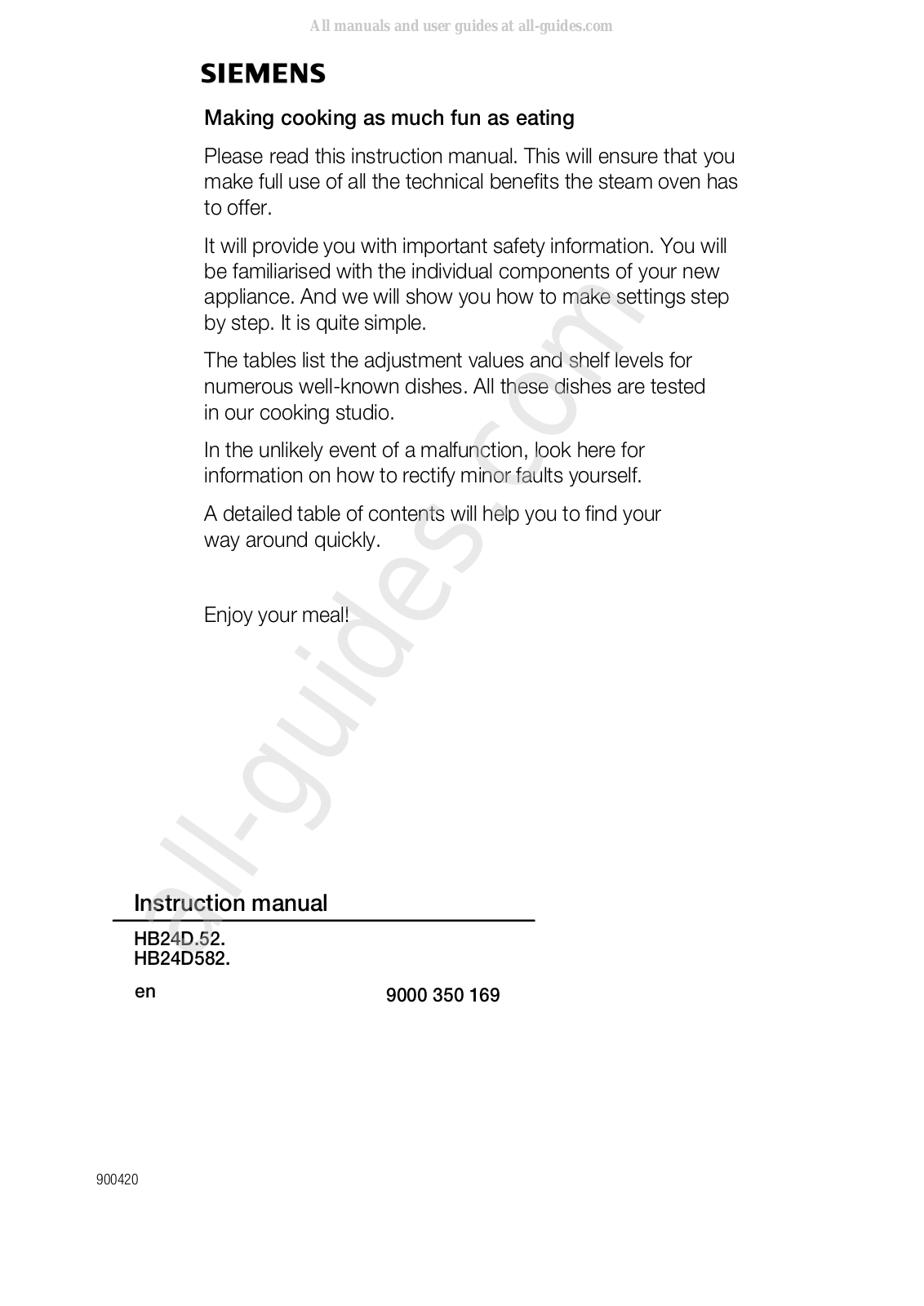
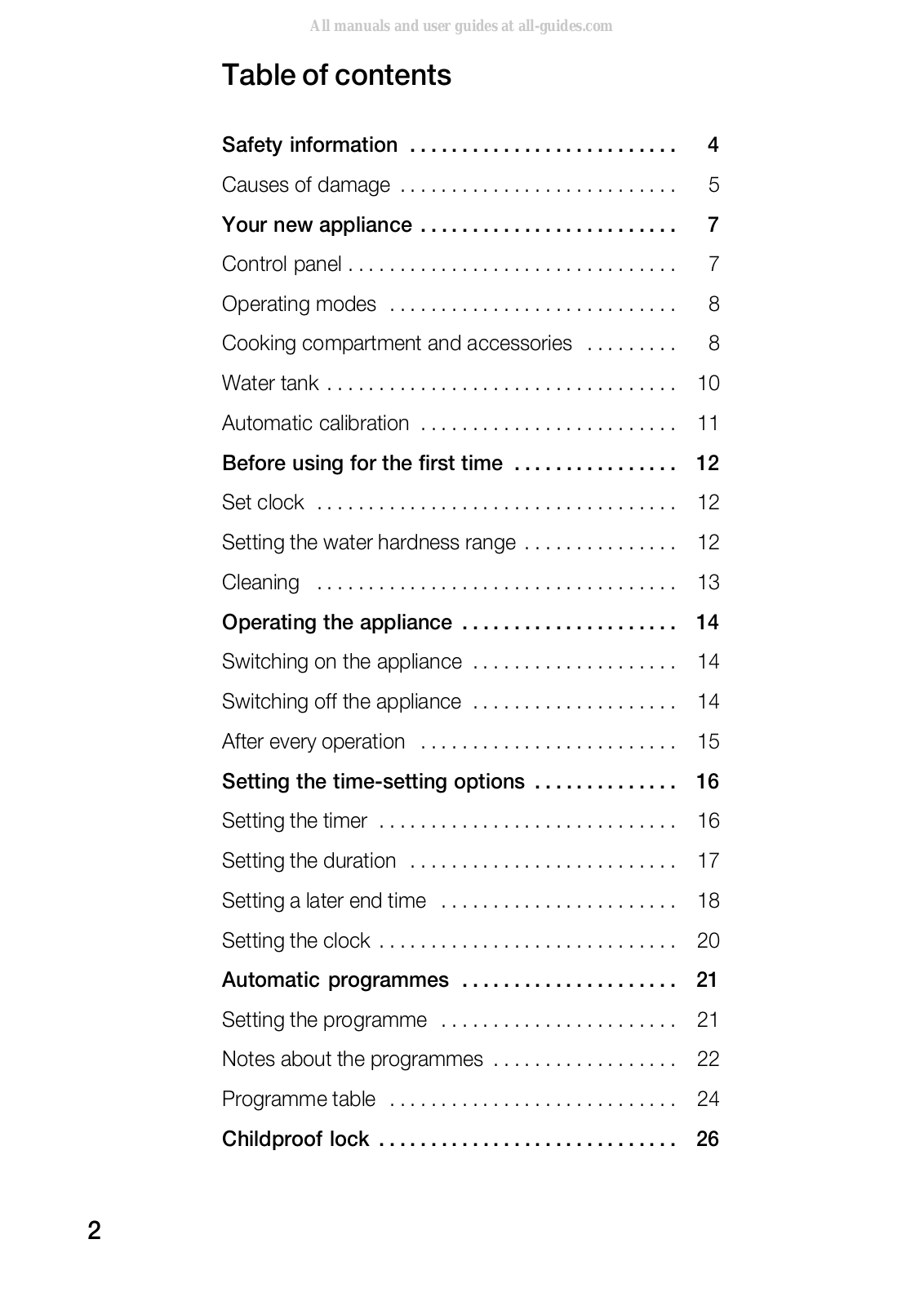
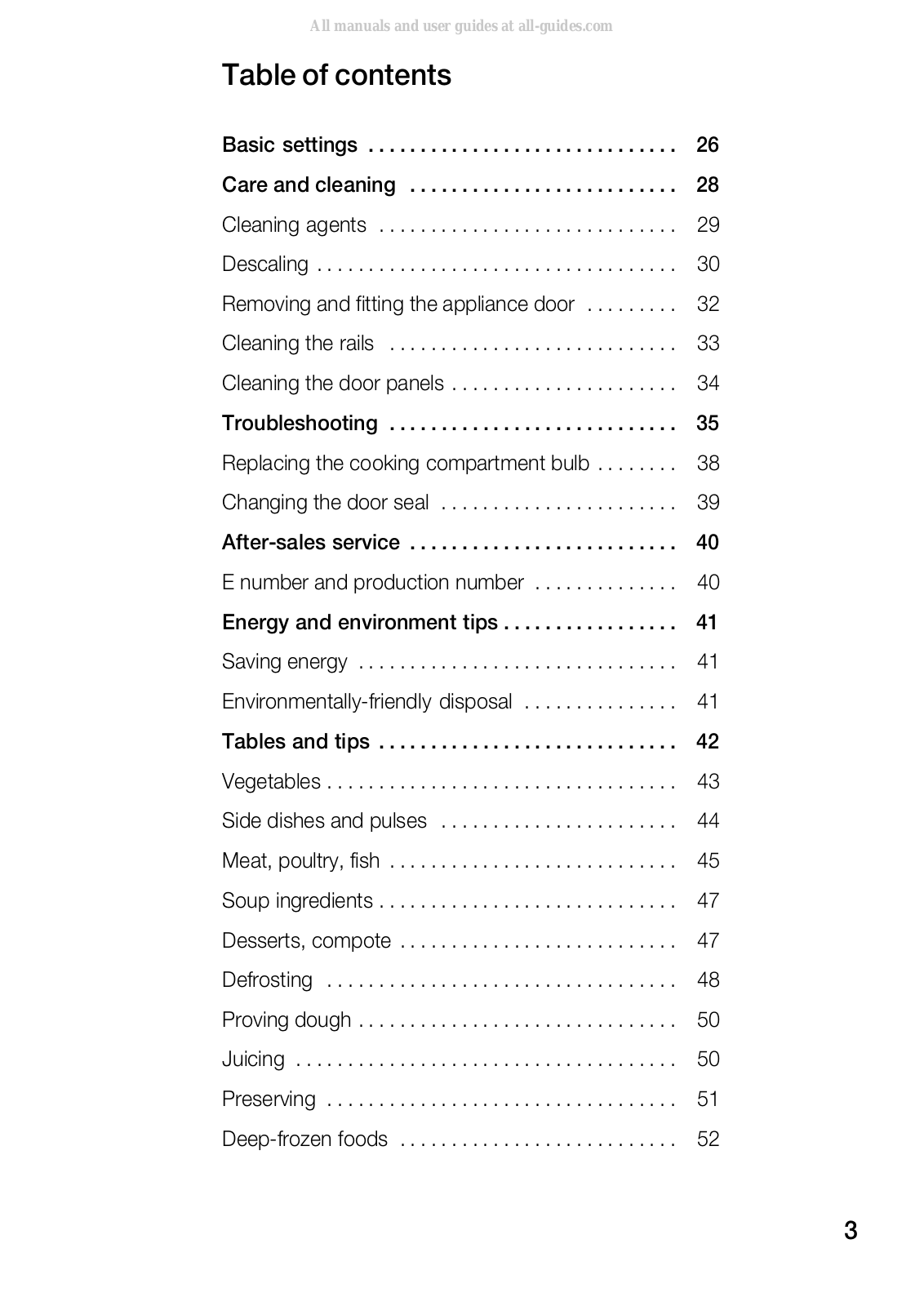
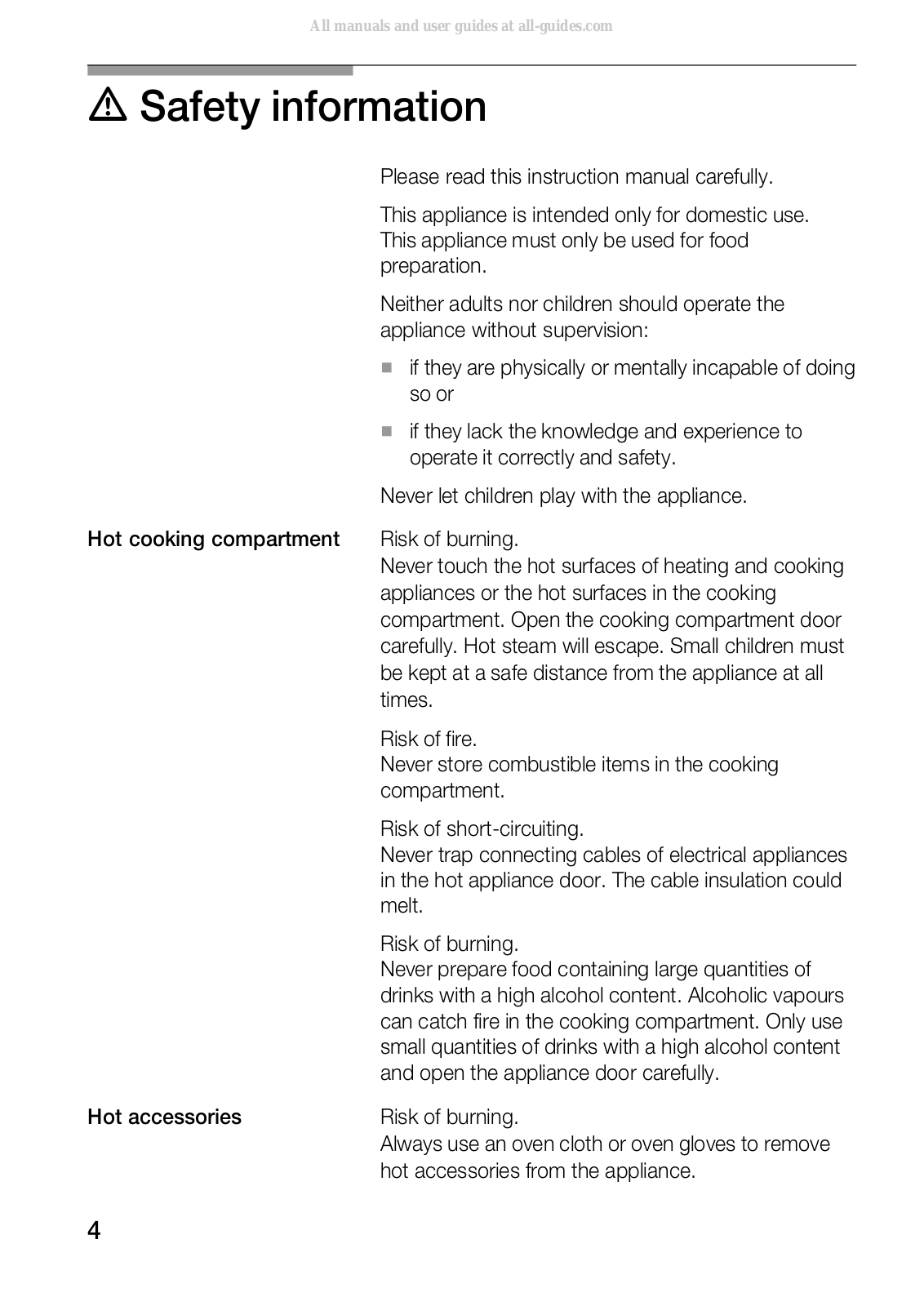
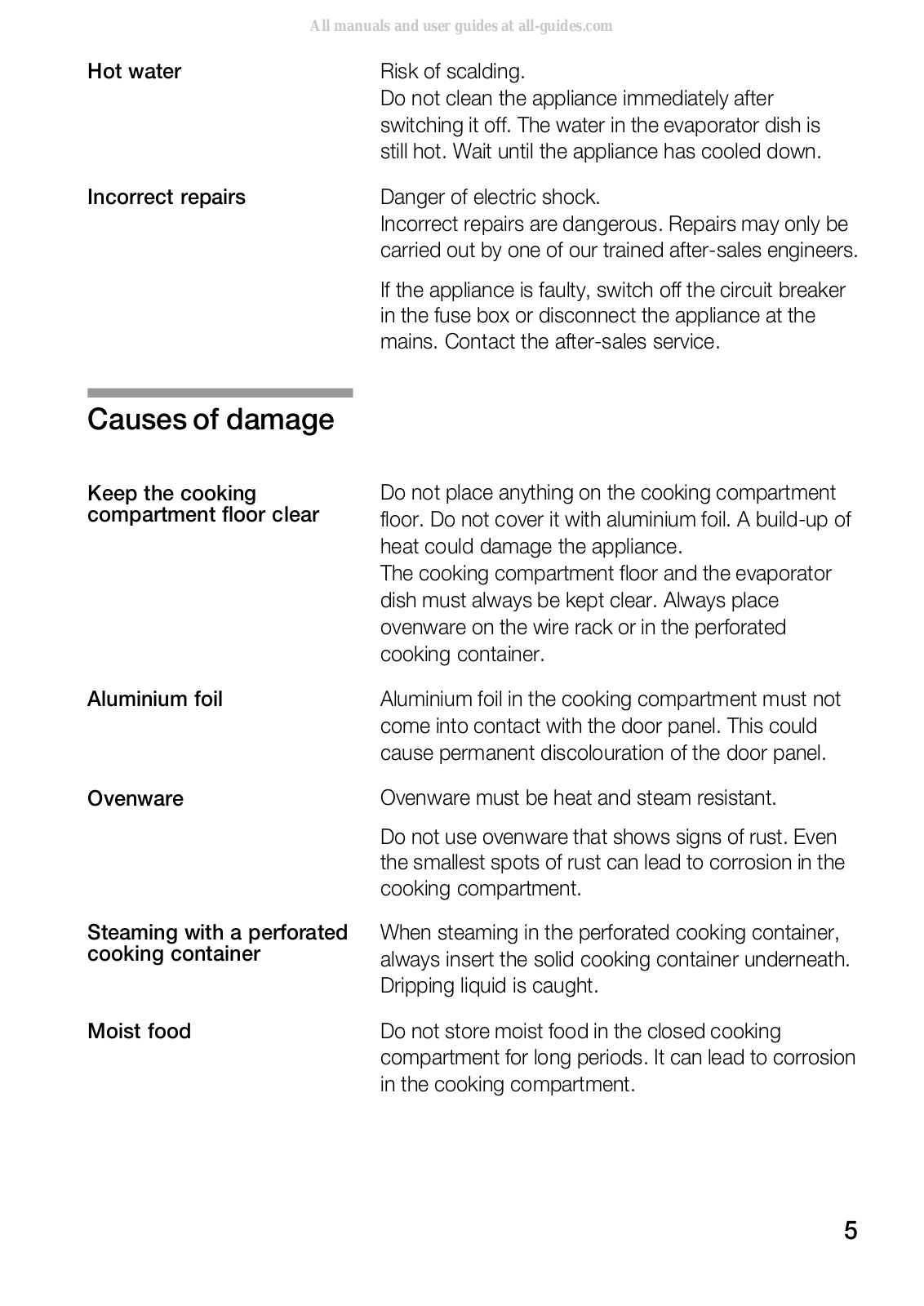
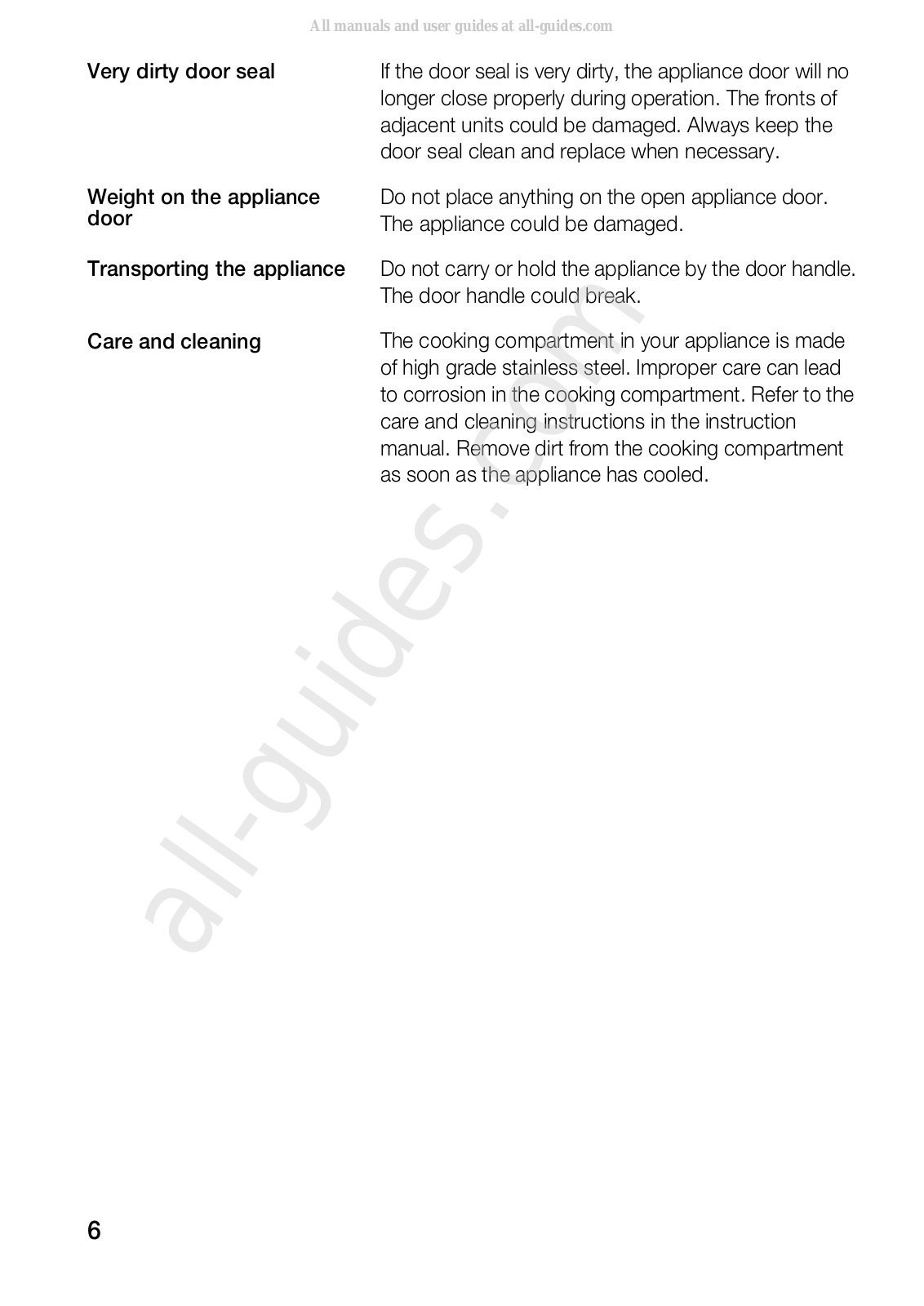

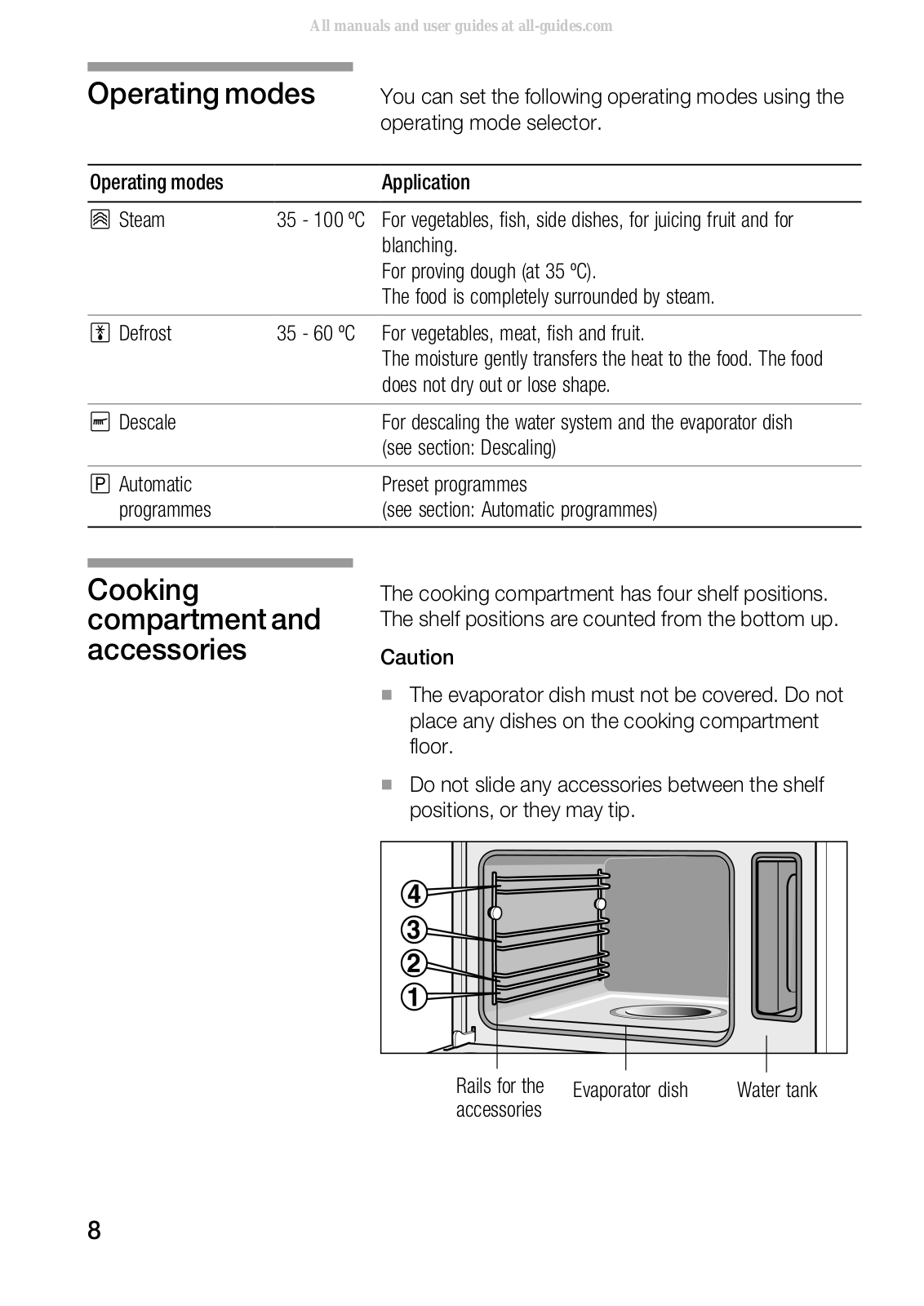
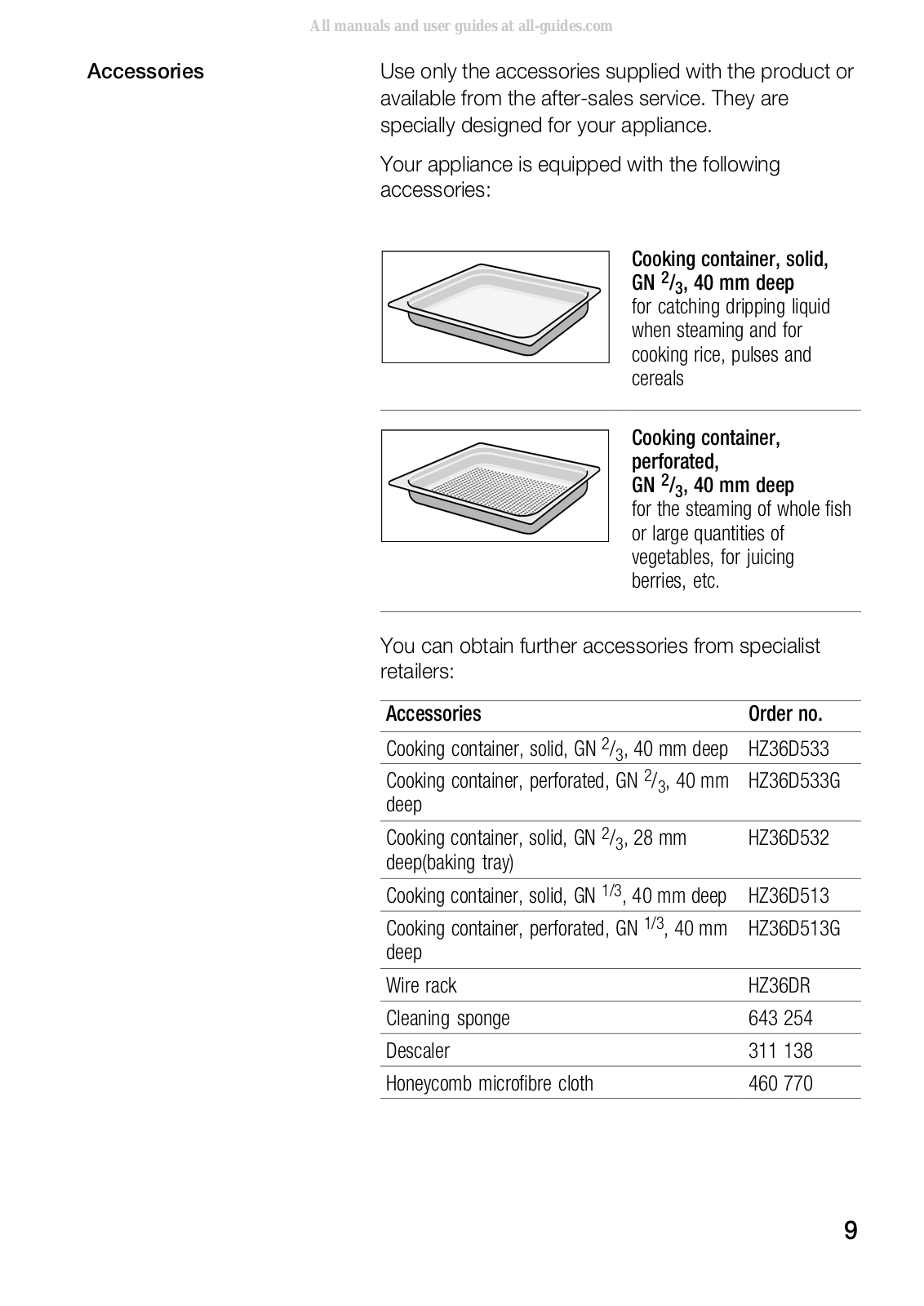
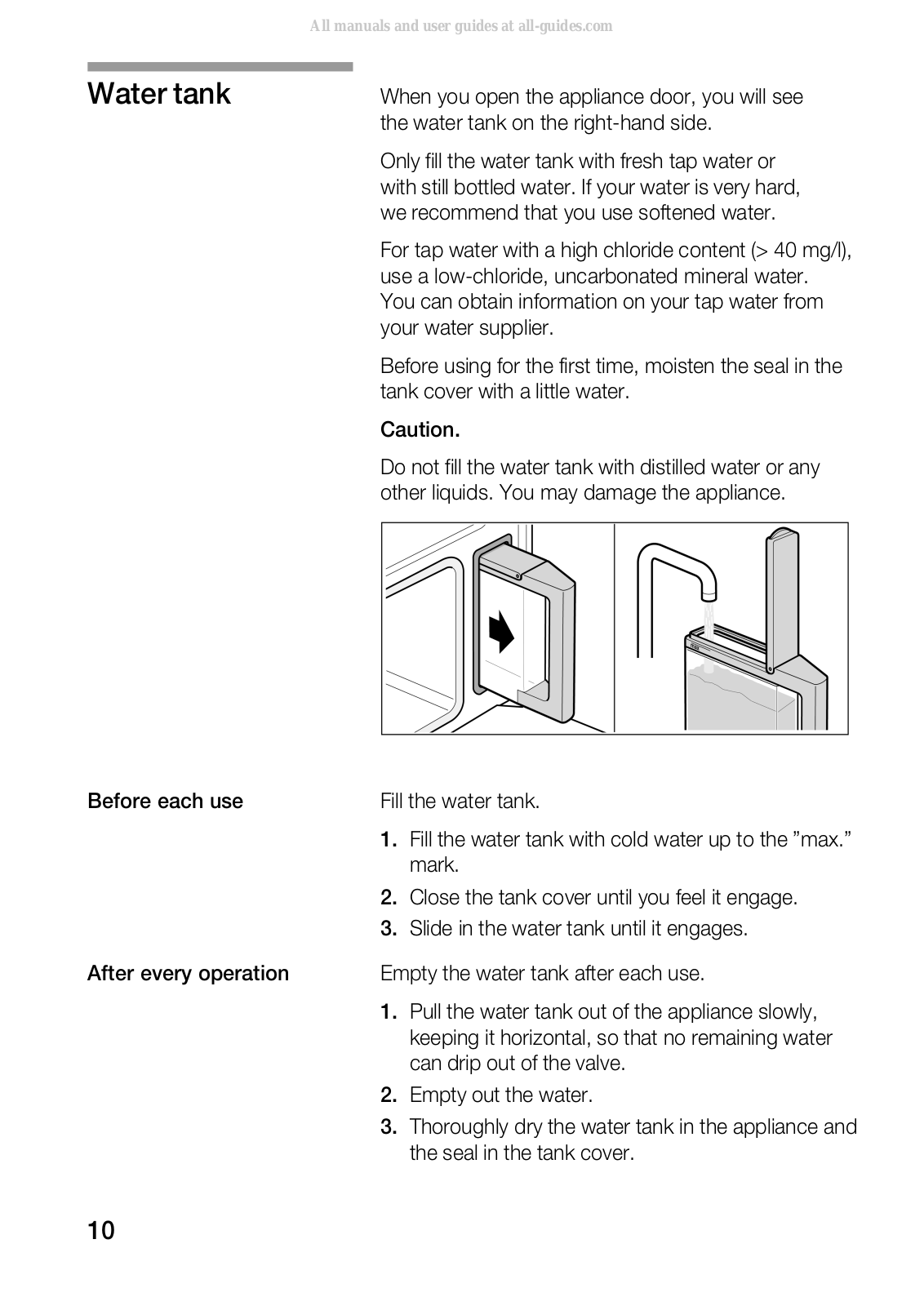
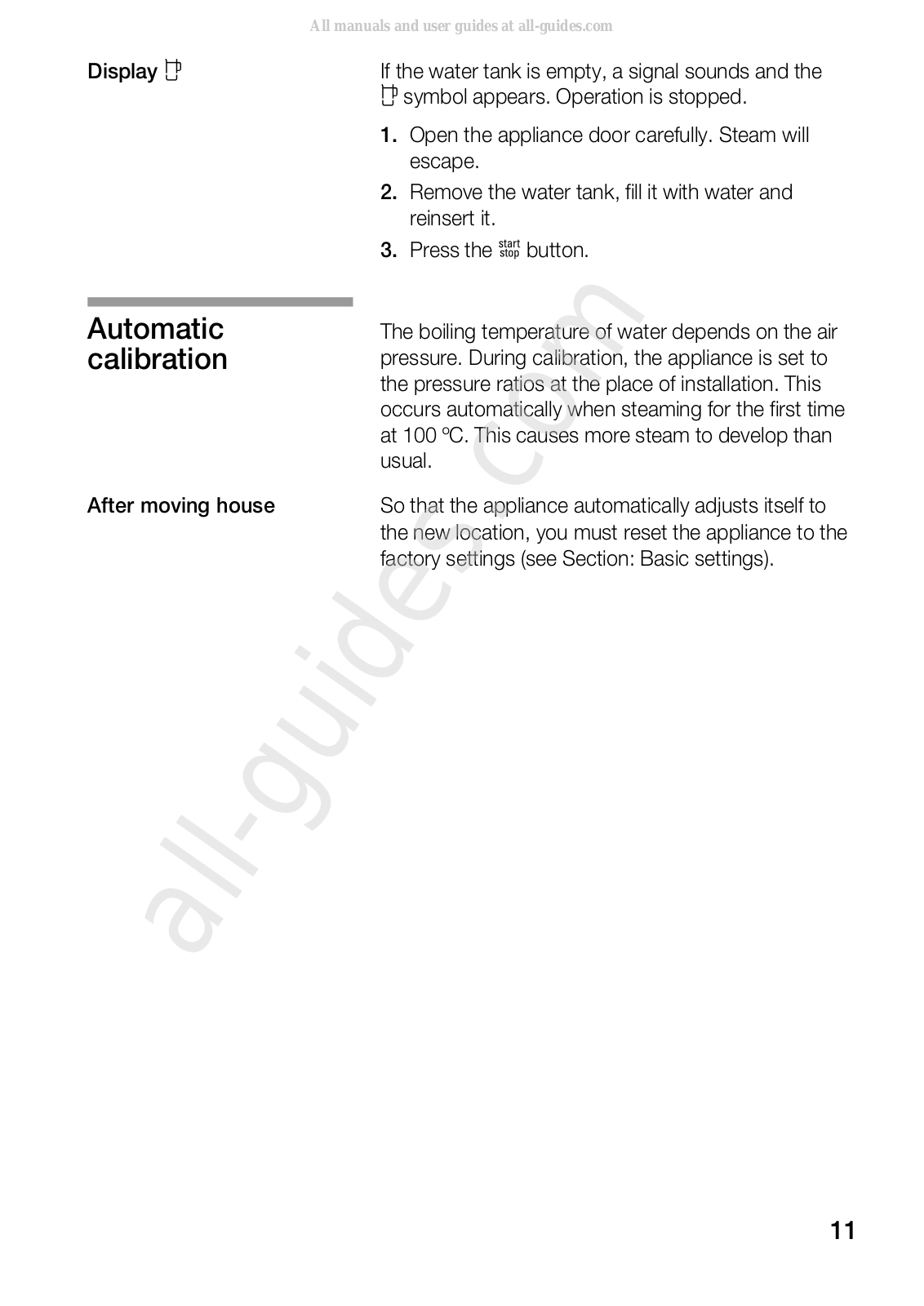
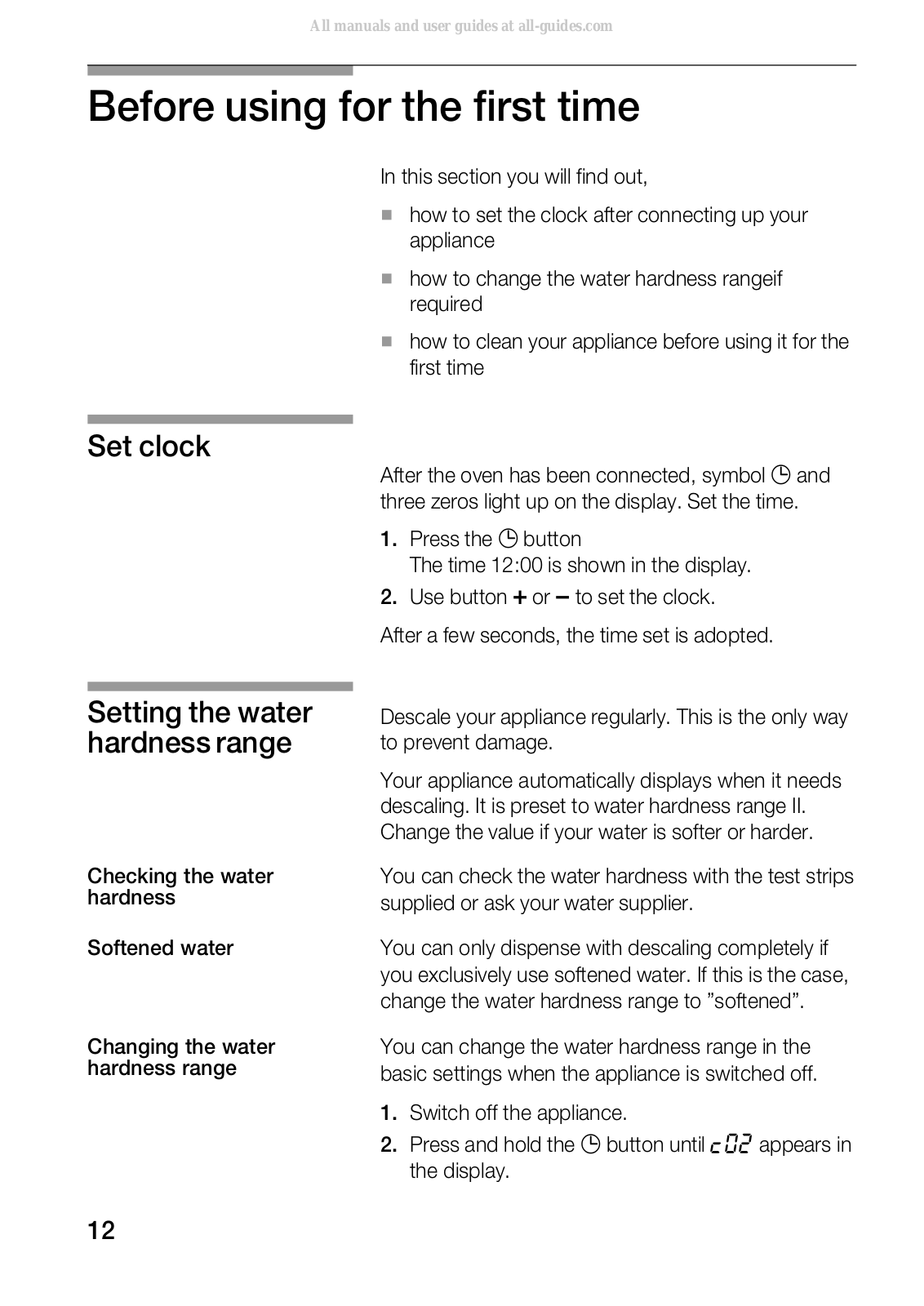
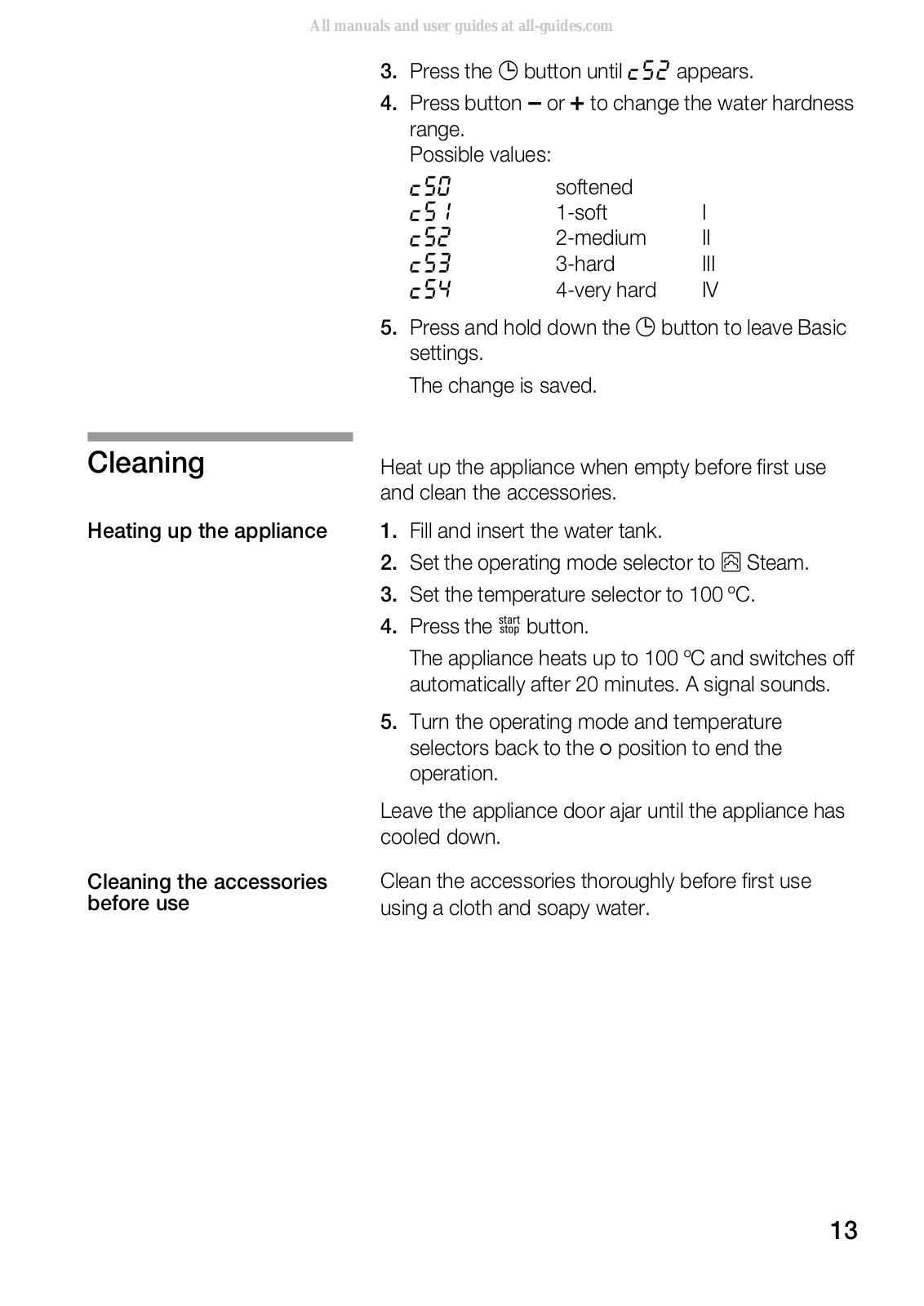
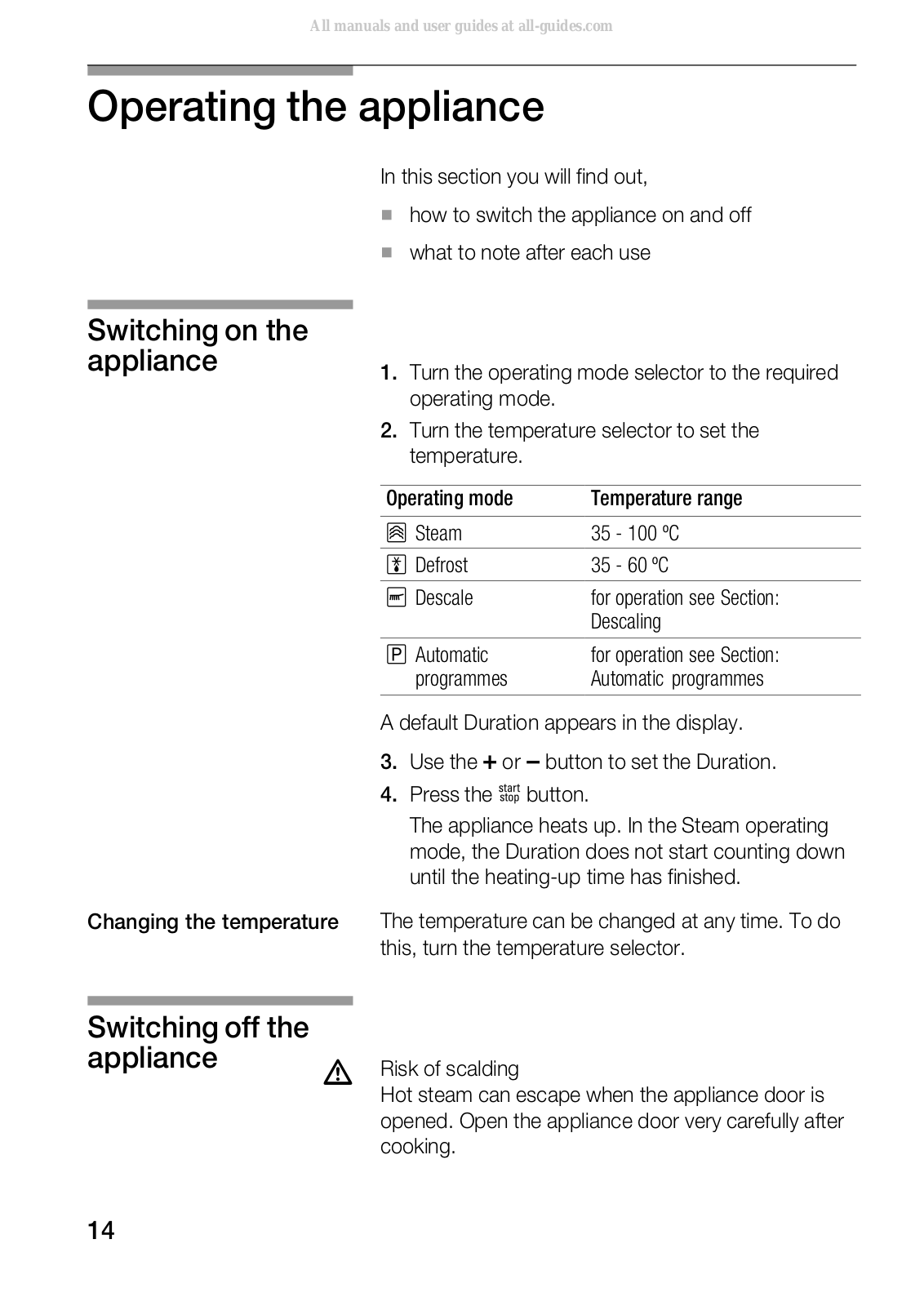
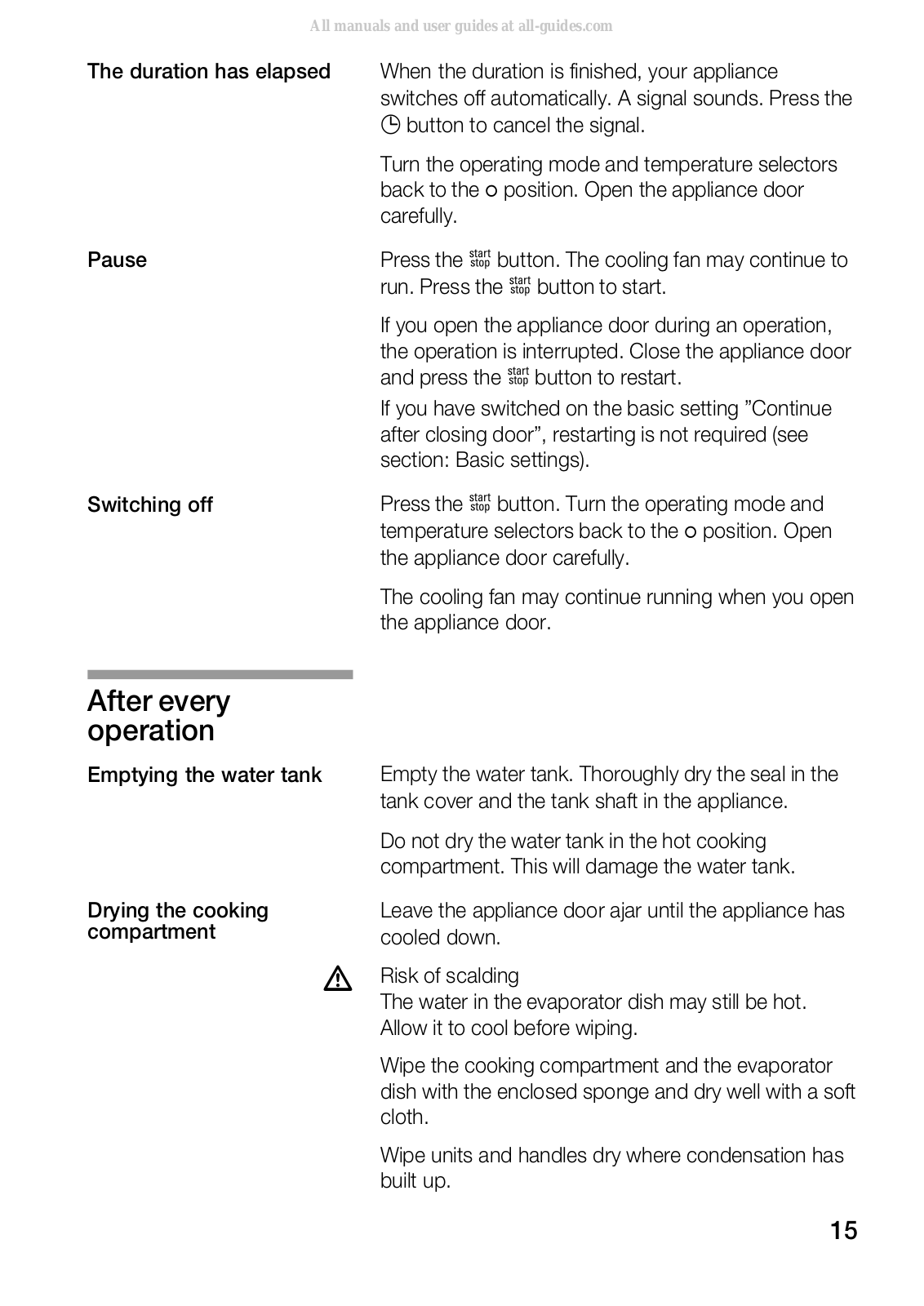
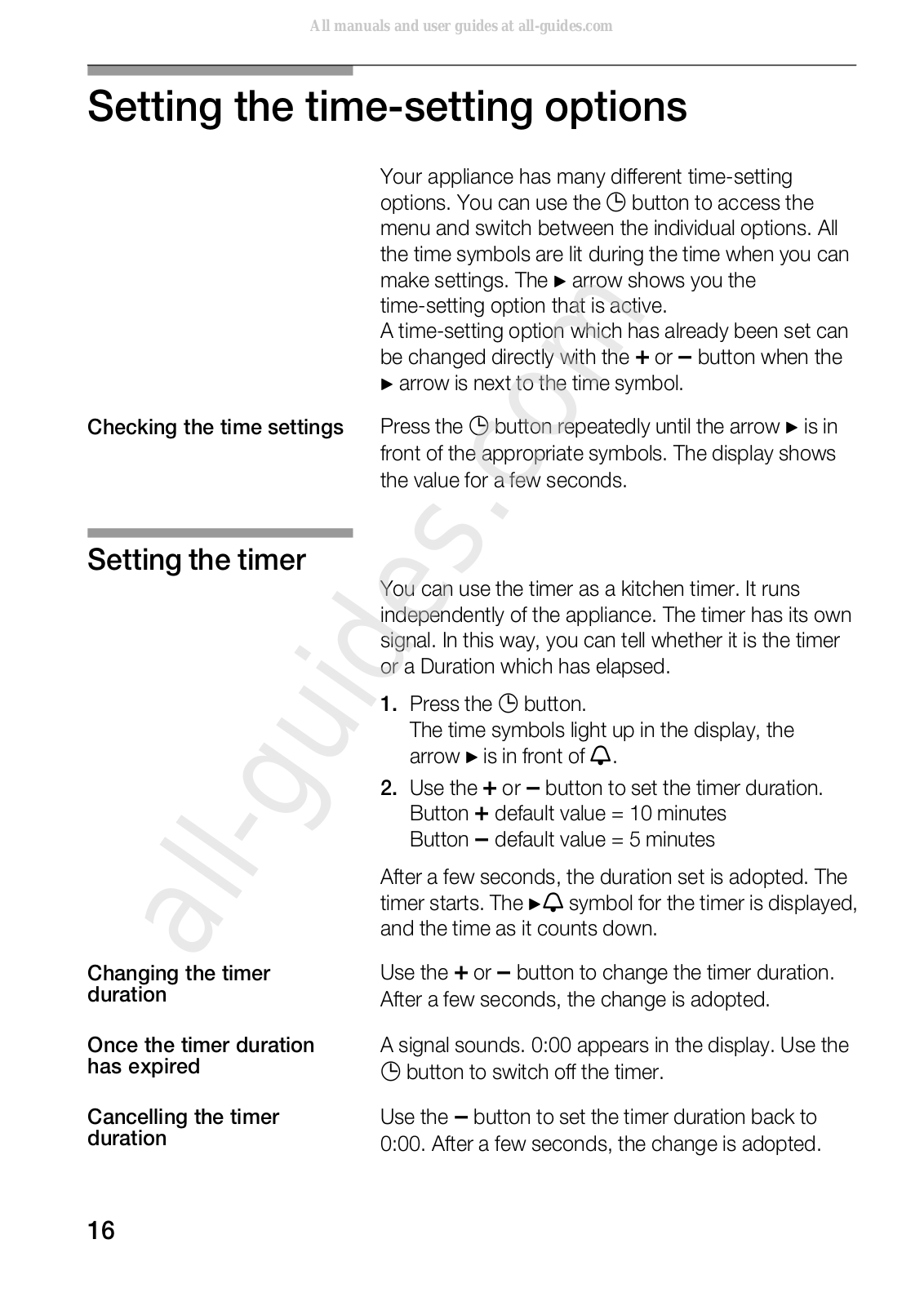
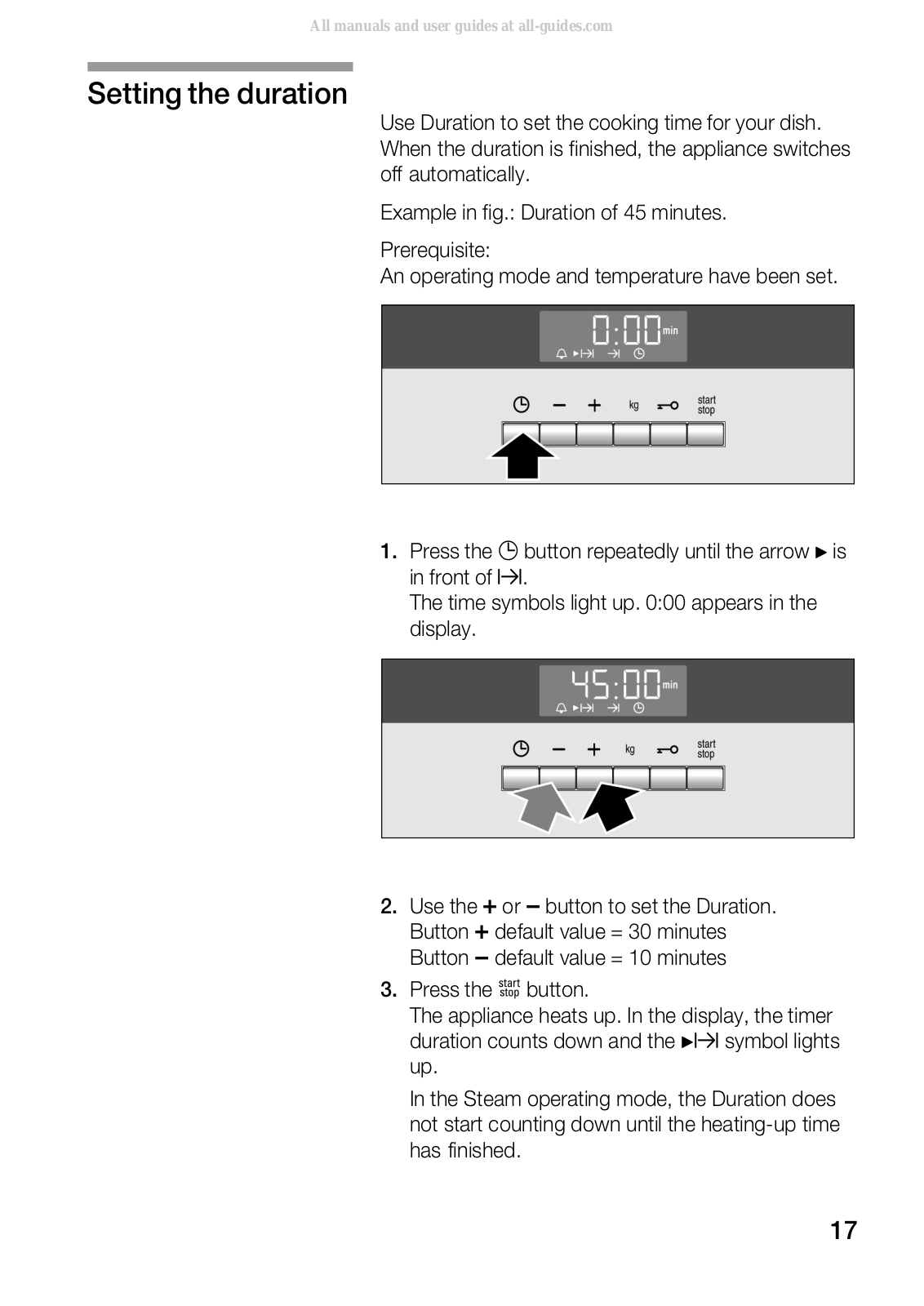







































